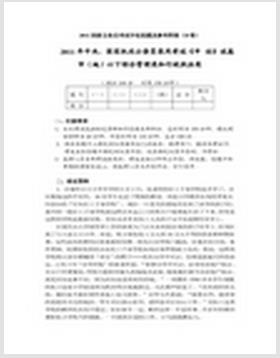大别地质体双河地区与超高压榴辉岩关系密切的大别地质体双河地区与超高压榴辉岩关系密切的片麻岩类型有黑云母副麻岩和花岗正长麻岩两种。磷灰石和寄主片麻岩中大块碳的浓度和同位素组成可以采用EA-MS在线技术测定。采用XRD和FTIR技术对磷灰石内部碳酸盐结构进行了检测,尽管这些片麻岩中的δ18O值从-4.3‰到+10.6‰不等,但是在磷灰石中观察到的CO2中碳浓度为0,70-4.98wt.%,δ13C的值在-28.6‰到-22.3‰之间。片麻岩内部数十米尺度范围内的δ13C和δ18O均存在明显的非均质性,说明超高压变质后存在二次变质。部分的片麻岩以δ13C贫化为主,但在超高压变质作用下,富集δ13C的CO2流体流动导致碳酸盐中碳含量升高。片麻岩中δ13C贫碳被解释为其前身在板块俯冲前遭受了大气热液蚀变,磷灰石中δ13C值低以及结构碳酸盐含量低,说明超高压变质流体中存在贫δ13C 的CO2。贫δ13C 的CO2无疑是超高压变质过程中地下流体有机物氧化的产物。
花岗岩正长岩的两个样品锆石的δ18O值较低,在-4.1‰ 到-1.1‰之间,说明其原岩在岩浆结晶前的18O中已明显耗竭。18O贫锆石U-Pb不整合年代为花岗正长岩原岩724-768 Ma的新元古代,与大别苏鲁造山带大部分榴辉岩和正长岩的原岩年龄一致。因此,大气热液蚀变直接发生在新元古代中期,可能与罗丁岛超大陆断裂和雪球事件有关。因此推断火成岩的花岗质正片麻岩原岩和榴辉岩会沿着新元古代扬子板块的北部边缘,侵入到年长序列作曲沉积黑云副片麻岩和一些榴辉岩的原岩中,推动当地大气热液循环系统使得13C和18O与这些暴露在大别山岩层的超高压岩石相作用。
方案详情

Available online at www.sciencedirect.comLITHOSLithos 70 (2003) 321-343 322Y.-F. Zheng et al. / Lithos 70 (2003) 321-343 www.elsevier.com/locate/lithos Two types of gneisses associated with eclogite at Shuanghein the Dabie terrane: carbon isotope, zircon U-Pb datingand oxygen isotope Yong-Fei Zheng*, Bing Gong, Zi-Fu Zhao, Bin Fu, Yi-Liang Li School of Earth and Space Sciences, University of Science and Technology of China, Hefei 230026, PR China Abstract There are two types of gneisses, biotite paragneiss and granitic orthogneiss, to be closely associated with UHP eclogite atShuanghe in the Dabie terrane. Both concentration and isotope composition of bulk carbon in apatite and host gneisses weredetermined by the EA-MS online technique. Structural carbonate within the apatite was detected by the XRD and FTIRtechniques. Significant 3C-depletion was observed in the apatite with 8c values of -28.6% to -22.3% and the carbonconcentrations of 0.70-4.98 wt.% CO2 despite a large variation in 8180 from - 4.3%o to +10.6%o for these gneisses. There issignificant heterogeneity in both 813C and 818o within the gneisses on the scale of several tens meters, pointing to the presenceof secondary processes after the UHP metamorphism. Considerable amounts of carbonate carbon occur in some ofthe gneissesthat were also depleted in 1’c primarily, but subjected to overprint of 13C-rich CO2-bearing fluid after the UHP metamorphism.The13c-depleted carbon in the gneisses is interpreted to be inherited from their precursors that suffered meteoric-hydrothermalalteration before plate subduction. Both low 8C values and structural carbonate in the apatite suggest the presence ofc-poorCOz in the UHP metamorphic fluid. The 13c-poor CO is undoubtedly derived from oxidation of organic matter in thesubsurface fluid during the prograde UHP metamorphism. Zircons from two samples of the granitic orthogneiss exhibit low 8180 values of - 4.1%o to-1.1%o, demonstrating that itsprotolith was significantly depleted in 180 prior to magma crystallization. U-Pb discordia datings for the 18O-depleted zirconsyield Neoproterozoic ages of 724-768 Ma for the protolith of the granitic orthogneiss, consistent with protolith ages of mosteclogites and orthogneisses from the other regions in the Dabie-Sulu orogen. Therefore, the meteoric-hydrothermal alterationis directly dated to occur at mid-Neoproterozoic, and may be correlated with the Rodinia supercontinental breakup and thesnowball Earth event. It is thus deduced that the igneous protolith of the granitic orthogneiss and some eclogites would intrudeinto the older sequences composing the sedimentary protoliths of the biotite paragneiss and some eclogites along the northernmargin of the Yangtze plate at mid-Neoproterozoic, and drove local meteoric-hydrothermal circulation systems in which both13C- and 18O-depleted fluid interacted with the protoliths of these UHP rocks now exposed in the Dabie terrane. C 2003 Elsevier B.V. All rights reserved. Keywords: Carbon isotope; Oxygen isotope; U-Pb dating; Zircon; Gneiss; UHP metamorphism ( * Corresponding author. Tel.: + 8 6-551-3603384; fa x : +86 - 551- 3603554. ) E-mail address: yfzheng@ustc.edu.cn (Y.-F. Zheng). ( 0024-4937/$ - s e e f r ont matter C 2 0 03 Elsevier B.V. All ri g hts r e served.doi:10.1016/S0024-4937(03)00104-X ) 1. Introduction Since the discovery of coesite and micro-diamondinclusions in eclogites from the Dabie and Sulu ter- ranes in east-central China (Okay et al., 1989; Wang etal., 1989; Xu et al., 1992), these regions have been oneof the most important targets for studying ultrahighpressure (UHP) metamorphism during plate collisionand subduction. Anomalously low 88o values of-11%o to -8%o were found in eclogite and quartz-schist at Qinglongshan in the Sulu terrane (Yui et al.,1995; Zheng et al., 1996, 1998a; Rumble and Yui,1998), and less lower 8180 values of -5%o to -2%were reported for eclogites and associated gneisses inthe Dabie terrane (Baker et al., 1997; Yui et al., 1997;Zheng et al., 1998a, 1999; Fu et al., 1999, 2002).These have been interpreted to indicate a meteoric-hydrothermal alteration to protoliths of the UHP meta-morphic rocks at high temperatures before plate sub-duction at Triassic. In this regard, surface materials onthe continental crust were carried into the mantle byplate subduction, and the recycled crust has beenreturned to the surface in the suture zone of a conti-nent-continent collision. Rowley et al. (1997) hypothesized that the anom-alous 18O-depletion in the eclogite and quartz-schistat Qinglongshan in the Sulu terrane may reflect thedevelopment of hydrothermal circulation associatedwith Neoproterozoic magmatism and glaciation inthe northern margin of the Yangtze plate. An inspec-tion of their reasoning shows that the hypothesis wasbased on a U-Pb discordia age of 773 ±10 Ma forzircons from three samples ofO Igranitic orthogneiss atWumiao and Shima in the Dabie terrane. Theyassumed that the protolith age of the Qinglongshaneclogite in the Sulu terrane is similar to that mea-sured for the granitic orthogneiss in the Dabieterrane. However, not only the two localities forthe zircon U-Pb dating and the anomalous180-depletion are over 500 km far away from each other,but also eclogites having the normal mantle 8ovalues also occur in the vicinity of the anomalouslyO-depleted eclogite in the Sulu terrane (Zheng etal., 1998a). In additon, the 880 higher values thanthe normal mantle were reported for UHP eclogitesand gneisses in the Dabie terrane (Zheng et al.,1998a, 1999,2001; Fu et al., 1999). Although thehypothesis has been advanced by Rumble (1998),Rumble and Yui (1998) and Rumble et al. (2000), nodirect U-Pb dating has been made for 1O-depletedzircons from the UHP metamorphic rocks in the Dabieterrane. Two distinct types of gneisses can be distin-guished in the Dabie terrane according to theirpetrology and affinity to enclosed eclogites (Conget al., 1995; Wang et al., 1995). One type is of dark-gray colored micaceous schist or paragneiss, which isrich in biotite and closely associated with the eclo-gites (so-called eclogite-paragneiss unit thereafter).The other type is of voluminously light-coloredgranitic orthogneiss, which is composed mainly offeldspars and quartz and normally surrounds theeclogite-paragneiss unit. Premetamorphic intrusioncontact relations were often observed among theorthogneiss, eclogite and paragneiss. With respect tocontact relations between the eclogite-paragneissunit and the granitic orthogneiss during plate subduc-tion and UHP metamorphism, however, either foreignor in situ models were advocated previously. Asobserved by Cong et al. (1995) and Dong et al.(1996), the granitic orthogneiss is in fault contactwith the eclogite-paragneiss unit in some places atShuanghe. Coesite was recognized early in garnets from thebiotite paragneiss in the Dabie terrane (Wang andLiou, 1991; Cong et al., 1995). However, no UHPindex mineral was found in the granitic orthogneiss inthe last century. In view of the apparent difference inpressure between the eclogite-paragneiss unit and thegranitic orthogneiss in the Shuanghe area, it waspostulated that the granitic orthogneiss did not expe-rience the UHP metamorphism (e.g., Cong et al.,1995). As a result, the eclogite-paragneiss unit wasconsidered to be exotically emplaced into the graniticorthogneiss at mid-crustal levels during exhumation.However, Wang and Liou (1991) speculated that theregional granitic orthogneiss also suffered the UHPmetamorphism, but that the earlier UHP minerals hadbeen obliterated by the later amphibolite-facies over-printing during exhumation. Geological mapping ofXue et al. (1996) showed that the eclogite-paragneissassociation with the granitic orthogneiss in the Shimaarea shares a common structural history that includesfabrics developed at UHP conditions. Tabata et al.(1998) reported that coesite inclusions occur in zir-cons of amphibolite-facies gneisses at widespreadlocalities within the coesite-eclogite zones in theDabie terrane. Carswell et al. (2000) reported theoccurrence of rutile inclusions in titanite, high-Cagarnet and high-Si phengite in zoisite of the granitic orthogneiss from the eastern part of the Dabie terrane.Ye et al. (2000) identified coesite and omphaciteinclusions in zircon from the granitic orthogneiss atTaohang in the Sulu terrane. Lately, Liu et al. (2001)discovered that coesite occurs as zircon-hosted inclu-sions in all types of para- and orthogneisses in theDabie terrane, indicating that the orthogneiss hadshared the same UHP metamorphic history as theeclogite-paragneiss units that reside in it. Evidently,both granitic orthogneiss and biotite paragneiss host-ing the eclogites experienced the UHP metamorphicconditions. The eclogites, biotite paragneiss and granitic ortho-gneiss from Shuanghe in the Dabie terrane have beensubjected to extensive petrologic and geochemicalinvestigations (e.g., Zhai et al., 1992; Okay, 1993;Cong et al., 1995; Liou et al., 1997; Jahn, 1998;Carswell et al., 2000; Fu et al., 2001). Previous studieshave determined the oxygen and hydrogen isotopecompositions of the eclogites and gneisses in thisdistrict (Zheng et al., 1998a; Fu et al., 1999), carbonand oxygen isotope compositions of marbles (Zheng etal., 1998b; Rumble et al.,2000), and the carbonconcentration and isotopic composition of eclogitesand enclosed apatites (Zheng et al., 2000). A significantdifference in 88o was observed between the eclogite-paragneiss unit and the granitic orthogneiss atShuanghe (Fu et al.,1999), which was explained toimply a foreign contact with each other, like a tectonicmelange. It has been puzzling why the two types of thegneisses at Shuanghe exhibit different oxygen isotopebehavior despite the same UHP metamorphic condi-tions. Carbon isotope geochemistry can be helpful inthis aspect because there is a distinct difference incarbon isotope compositions between sedimentaryand igneous rocks (Deines, 1989; Hoefs, 1997). Inparticular, apatite is a common accessory mineral inmetamorphic rocks and its carbon isotope geochem-istry can provide very important information on theorigin of the carbon. This paper reports the concen-tration and isotopic ratio of carbon in both biotiteparagneiss and granitic orthogneiss from Shuangheand in apatite from the two gneisses. Zircon U-Pbdating and oxygen isotope analysis were also carriedout to define the protolith age of the granitic orthog-neiss and the timing of the meteoric-hydrothermalalteration. The results provide an insight into the scale and nature of fluid-rock interaction before and duringplate subduction. 2. Geological settings The coesite- and diamond-bearing metamorphicterranes in central-east China are divided from eastto west as Sulu, Dabie and Hong an terranes. They arecomposed of metamorphic rocks in grades fromgreenschist-facies to blueschist-facies to amphibo-lite-facies to eclogite-facies (Cong et al., 1994; Wanget al., 1995; Hacker et al.,1996). Tectonically, theyare situated within the collision belt between the Sino-Korean and Yangtze plates that extends in NWW-SEE direction for more than 2000 km (Liou et al.,1996). The eastern portion of the collision belt wasdisplaced more than 500 km by the sinistral NE-extended strike-slip Tan-Lu fault from the Dabieterrane to the Sulu terrane (Xu et al., 1987). The Dabie terrane is located to west of the Tan-LuFault (Fig. 1). It is divided into four metamorphicunits from north to south in terms of three main EWfaults: (1) Beihuaiyang low-grade unit, which consistsof slate, phyllite, metasandstone, schist and metaig-neous rocks of mainly greenschist-facies dynamicmetamorphism and is overlain by Jurassic-Creta-ceous molasse-like sedimentary and volcanic rocks;(2) North Dabie high-T/high-P unit, which consists ofabundant amphibolite-facies to granulite-facies rocksas well as some migmatitic gneisses and a few mafic-ultramafic complexes, and Mesozoic granitic rocks;(3) Central Dabie UHP unit, which consists of coesite-bearing eclogites, gneisses, marbles, jadeite quartzite,and minor ultramafic rocks; and (4) South Dabie low-T/high-Punit, which consists mainly of blueschist-facies rocks and epidote/amphibolite-facie rocks witha few low-temperature eclogites, and was sometimescalled as the Susong Group in the literature. TheXiaotian-Mozitan Fault separates the Beihuaiyanglow-grade unit from the North Dabie high-T/high-Pcomplex, Taihu-Mamiao Fault separates the SouthDabielow-T/high-Punit from the Central Dabie UHPunit, and the Wuhe-Shuihou Fault separates NorthDabie from Central Dabie (Fig. 1). Eclogites in Central Dabie occur normally in threemodes (Zhai et al., 1995; Wang et al.,1992): (1)layered bodies intercalated with garnet peridotites; (2) Fig. 1. Sketch map of geology in the Dabie terrane (revised after Cong et al., 1995). Petrotectonic units: (I) Beihuaiyang low-grade rocks; (II)North Dabie high-T/high-P complex; (III) Central Dabie UHP complex; (IV) South Dabie low-T/high-Pcomplex (the Susong Group);(V)Foreland fold-and-thrust belt. Circled number denotes the fault: ①Xiaotian-Mozitan Fault,② Wuhe-Shuihou Fault, and ③ Mamiao-TaihuFault. interlayered UHP bodies mainly composed of eclogiteand biotite paragneiss; and (3) small eclogite lensesand enclosures in impure marbles. The present studyfocuses on the biotite paragneiss closely associatedwith the UHP eclogite and their surrounding graniticorthogneiss at Shuanghe in Qianshan County, AnhuiProvince, which is located in the eastern part ofCentral Dabie (Fig. 1). As shown by Cong et al.(1995) and Liou et al. (1997), the eclogite-paragneissunit at Shuanghe forms an elongated tectonicallybounded slab, with NNW-SSE direction, exposedover an area of about 1 km(Fig.2). Within this unit,the biotite paragneiss occurs as compositional layerswith eclogite, marble and jadeite quartzite. It is separated by a dextral strike-slip strike fault into twoslabs, which are surrounded by the granitic orthog-neiss. A Mesozoic granitic body occurs at its north-west. Coesite and coesite pseudomorphs as inclusionswere observed in both jadeite and garnet from thejadeite quartzite (Liou et al.,1997). A number of studies of the petrographic features,mineral parageneses and mineral compositions havebeen conducted for eclogites, gneisses and jadeitequartzite at Shuanghe (e.g., Okay, 1993; Cong et al.,1995; Liou et al., 1997; Carswell et al., 2000). Para-genesis of the granitic orthogneiss is garnet (highspessartine, low pyrope)+phengite (Si=3.21-3.35pfu)+plagioclase (An=3-11)+K-feldspar+epido- te+biotite. Paragenesis of the biotite paragneiss isgarnet (almandine-rich)+phengite (Si=3.4-3.6pfu)+plagioclase (An=16-29)+epidote+rutile/tita-nite+biotite. High-Si phengite is best presented asinclusions within garnet. Metamorphic paragenesesand kelyphitic texture in the jadeite quartzite also reveala multistage metamorphic evolution and complex ex-humation history (Liou et al., 1997). It was estimated by Cong et al. (1995) that thebiotite paragneiss has P-T conditions of 470-570°Cand 6-8 kbar, whereas the granitic orthogneiss yieldsT=450±50°C at P=4 kbar. These P-T conditionsare concordant with retrograde metamorphism at lowamphibolite-facies conditions. However, mineral-pairoxygen isotope geothermometry of Fu et al. (1999)suggested that the eclogite-facies metamorphic tem-peratures of 750-600 °C have been preserved in thebiotite paragneiss, and that the granitic orthogneissexperienced metamorphism at 550-690°C responsi-ble for high amphibolite-facies conditions. A compar-ative thermobarometric evaluation of both paragneissand orthogneiss has been undertaken by Carswe41ll etal. (2000). The results indicate that the graniticorthogneiss has followed a common subduction-relat-ed clockwise P-T path with the UHP paragneiss andeclogites through conditions of Pmax at ca. 690-715C and 36 kbar to Tmax at ca. 710-755°C and 18kbar, prior to extensive recrystallization and reequili-bration of the ductile orthogneiss at ca. 400-450°Cand 6 kbar. A detailed Sm-Nd, Rb-Sr and U-Pb isotopicdatings have been carried out by Li et al. (1997,2000), Chavagnac et al. (2001) and Ayers et al.(2002) for the eclogites, biotite paragneiss, graniticorthogneiss and jadeite quartzite from Shuanghe. Sm-Nd mineral isochron dating gave ages of 226 ±3 and242 ± 3 Ma for the eclogites,227±2,231 ±35 and246 ±2 Ma for the biotite paragneiss, and 213 ±5Mafor the granitic orthogneiss. Rb-Sr mineral isochrondating yielded ages of 174±8 Ma for the eclogite,167±3 to 202 ±6 Ma for the biotite paragneiss, and ( F ig. 2 . Simplified geological map for metamorphic r ocks a t Shuanghe i n t h e D a bie terrane ( r evised after C ong et a l ., 1 995) . ( 1) G ranitic o rthogneiss; ( 2 ) e c logite; ( 3 ) j a deitic q uartzite; ( 4) marble; ( 5) b iotite paragneiss (including micaceous schists); (6) M esozoic granite; ( 7 ) f a ult; ( 8) sample l o cality. H, W and S de n otethe village of Hangjiacun, W angdawu and Shu a nghe, resp e ctively. ) 171±3 and 173±3 Ma for the granitic orthogneiss.Zircon U-Pb dating of Wetherill-type discordiaobtained the lower intercept ages of 237±4 and233 ±21 Ma for the biotite paragneiss, and 219±41Ma for the granitic orthogneiss. Along with the otherisotope datings, Li et al. (2000) proposed two stagesof rapid cooling for the eclogites and gneisses,corresponding to turnovers in time to Late Triassicfor the UHP eclogite-facies metamorphism and to EarlyJurassic for amphibolite-facies retrogression, respec-tively. However, Ayers et al. (2002) interpreted theirnew ionprobe U-Th-Pb dating of zircon and monazitefrom the jadeite quartzite as indicating the peak UHPmetamorphic event at 230-240 Ma and amphibolite-facies regression at ~ 210 Ma, respectively. The Triassic UHP metamorphism has been docu-mented by a growing body of U-Pb, Sm-Nd, Rb-Sr and Ar-Ar isotopic ages in the range of 245-210Ma (Ames et al., 1993, 1996, Li et al., 1993, 1994,1997, 1999a,2000; Okay et al., 1993; Hacker andWang, 1995; Chavagnac and Jahn, 1996; Rowley etal., 1997; Hacker et al., 1998, 2000; Maruyama et al.,1998; Webb et al., 1999; Chavagnac et al., 2001;Ayers et al., 2002), but there is still a controversy onits exact timing between Early Triassic and LateTriassic. Ernst and Liou (1999) proposed that thepeak metamorphic ages for the UHP mineral assemb-lages in the Dabie terrane may be 245-240 Ma, withexhumation to deep crustal levels by~230 Ma forthe HP eclogite-facies recrystallization; the assemb-lages have been intensively overprinted by highamphibolite-facies metamorphism at ~ 200 Ma. Thisproposal is supported by discussion concerning thediffusion kinetics of radiogenic elements in isochronminerals, in that the closure of the radiometricsystems in the UHP minerals is expected to occurconsiderably some time after the attainment of max-imum subduction depth (Zheng et al., 2002). There-fore, the exact timing of the ultrahigh pressuremetamorphism in the Dabie-Sulu terranes may beat Early-Middle Triassic rather than Late Triassic. indicate a Caledonian event (magmatism and/or meta-morphism) in the region and possibly point to the timeof oceanic plate subduction. The protolith ages of thegranitic or tonalitic orthogneiss have been dated to be810-625 Ma by the zircon U-Pb discordia method(Ames et al., 1996; Rowley et al., 1997; Xue et al.,1997, 2002; Hacker et al., 1998, 2000; Chen et al.,2000; Chavagnac et al., 2001), which are interpreted asthe timing of widespread intrusion of protolith granitesin the northern margin of the Yangtze plate. As datedby the zircon U-Pb method in this study, protolith ofthe granitic orthogneiss at Shuanghe is also of Neo-proterozoic ages. However, protolith ages of 1828 ±16and 2458 ±76 Ma were dated by zircon U-Pb dis-cordia method for the biotite paragneiss at Shuanghe(Li et al., 1997; Chavagnac et al., 2001), dissimilar tothose measured for the granitic or tonalitic orthogneissin the other regions of the Dabie terrane. So does adiscordia upper-intercept age of 1921 ±22 Ma by theionprobe method for zircons from the jadeite quartziteat Shuanghe (Ayers et al., 2002). 3. Analysis methods 3.1. Samples Fourteen samples of biotite paragneiss and onesample of jadeite quartzite were taken from theeclogite-paragneiss unit, and eight samples of thegranitic orthogneiss were taken from the surround-ing rock (Fig. 2). Apatite separates were obtainedby a combination of heavy liquid techniques andhand picking under a binocular microscope. Adetailed description of the present samples has beengiven by Fu et al. (1999), who carried out theoxygen and hydrogen isotope analyses of mineralseparates and obtained a large variation in 88o(-4.3%o to +10.6%o) for the biotite paragneiss,but a small range in 818o (-3.8%o to +1.2%o) forthe granitic orthogneiss. Petrology of jadeite quartz-ite at Shuanghe was well described by Liou et al.(1997). The biotite paragneiss consists of biotite, quartz,plagioclase (An=16-29), garnet (Mg- and Ca-rich),phengite, and epidote with such accessory minerals astitanite and/or rutile and ilmenite. Samples 94M48 and95M13 contain amphibole and thus are essentially amphibole schist. Samples 94M51 and 94M56 arelocated within the eclogite-paragneiss unit (Fig. 2),but they are similar to the granitic orthogneiss in thetexture observed under microscope. The graniticorthogneiss is composed of sodic plagioclase (An=3-11), microcline and quartz with minor amounts ofgarnet (Mn-rich), biotite, epidote, phengite and titan-ite. The abundance of individual minerals from bothgneisses has been determined under microscope by Fuet al. (1999). Apparently, the biotite paragneiss con-tains much more biotite than the granitic orthogneiss. Apatite occurs as both inclusion within garnet andintergranular mineral in the matrix of the gneisses. X-ray diffraction (XRD) and Fournier transform infraredspectroscopic (FTIR) analyses show that all of theapatite has detectable amounts of structural carbonateby substituting [PO4]. As depicted in Fig. 3, a FTIRspectrum of apatite from a sample of granitic orthog-neiss (94M57) principally consists of three portionsinvolving vibrational frequencies of OH, [CO3]and[PO4],respectively. There is significant asymmetric stretch (v3) of mode vibration at 1455 and 1429cm, indicating the presence of structural carbonate.This is significantly different from the case in south-western Greenland where graphite inclusions wereobserved in grains of apatite in banded-iron formationfrom Akilia island (Mojzsis et al., 1996). 3.2. Carbon concentration and isotopic ratio Concentration and isotope composition of bulkcarbon in both gneiss and apatite were determined byEA-MS online techniques using a EA1110 ElementalAnalyzer and a Delta+ mass spectrometer at Hefei. AConFlo II split interface was used to provide anefficient transfer of the output from the elementalanalyzer into the ion source of the mass spectrometer.In principle, samples were combusted in an O2 flow bya flash combustion reaction at~1800°C in theelemental analyzer, CO2 was separated from the othercombustion gases by gas chromatography and enteredthe mass spectrometer through the split interface for Fig. 3. A FTIR spectrum of apatite in granitic gneiss (94M57) from Shuanghe in the Dabie terrane. the measurement of isotopic ratios. A detailed descrip-tion was presented by Zheng et al. (2000) to outline theanalytical procedures of the EA-MS online techniquefor extracting CO2 from silicate rocks. In order to remove carbonates from the gneisses, thesame powders of whole-rock samples were treatedwith 5 N HCl solution before the EA-MS onlineanalysis. As a result, noncarbonate carbon in thewhole-rock samples was measured. A number ofwhole-rock samples with the very low carbon content(<300 ppm) were analyzed repeatedly by increasingthe sample weight by a factor of10, and the resultsobtained are in good agreement with the initial anal-yses within the uncertainties of both carbon concen-tration and isotopic ratio. In general, both high- and low-temperature carbon(probably present in the form of hydrocarbon, con-densed carbonaceous film, submicroscopic inclusionsof graphite, carbonates, inclusion CO2 and organiccarbon) have been extracted for concentration andia+isotopic analyses. As pointed by Zheng et al. (2000),however, it is not certain whether all of the carbon hasbeen extracted because the samples were melted in theflash combustion. During our analyses, it was ob-served that noncarbonate carbon appears to prefercombustion, leaving some of carbonate carbon in themelted glass. Furthermore, there is a possible removalof hydro-soluble carbon phase from the rock by HClleaching, resulting in a decrease in measured carboncontent of noncarbonate. As a consequence, not onlythe measured concentration and isotopic ratio of bulkcarbon may be only the minimum estimates for someof the samples in question, but the contribution fromnoncarbonate carbon may also be underestimated forboth concentration and isotopic ratio. In this regard,the concentration of carbonate carbon calculated bymass balance may be overestimated sometimes. Carbon isotope ratio is expressed in 8l3c withreference to the PDB standard, and duplicate analysesgive reproducibility better than ±0.5%o. The carboncontent in apatite is commonly expressed in CO2wt.% (1000 ppm C=0.3664 wt.%CO2). Duplicateanalyses for carbon concentration give reproducibilitybetter than ±100 ppm. Three standard materialswere also analysed by this approach, which yields813c values of -5.1±0.3%o for NBS-18 carbona-tite,, -10.3±0.3%o for IAEA-CH-6 sucrose and-16.3±0.3%o for USGS24 graphite, respectively, in good agreement with known standard 81c valuesof - 5.0%o, -10.4%o and -16.1%o 3.3. Zircon U-Pb dating and oxygen isotope Zircon was separated from two samples of graniticorthogneiss using standard techniques of density andmagnetic separation. Besides the consideration ofsize, clarity, color and morphology nonmagnetic zir-con grains were selected for isotopic analyses. U-Pb dating was performed by the conventionalisotope dilution technique of single zircons after airabrasion. Fraction size varied somewhat depending onU content and grain size of zircon. Zircon digestion,separation of U and Pb, and isotope dilution mass-spectrometry using a 205Pb-235u enriched tracersolution were made following the procedure describedby Krogh (1982). The total procedure blanks for Pband U are less than 0.05 and 0.002 ng, respectively.Isotope ratios are measured by single collector peak-jumping VG-354 mass spectrometer equipped with aDaly-type detector operating in ion-counting mode atTianjin Institute of Geology and Mineral Resources.Errors to the atomic and isotopic ratios are quoted atthe 2o confidence level. Common Pb corrections aremade by using the model Pb composition of Staceyand Kramers (1975). Thus only radiogenic Pb iso-topes are used in age calculations by means of theISOPLOT program of Ludwig (1994). Oxygen isotopic analysis was accomplished by theCO2 laser fluorination technique (Sharp, 1990) usinga 25-W MIR-10 CO2 laser at Hefei (Zheng et al.,2002). O2 was directly transferred to the Delta+ massspectrometer for the measurement of 180/0 and1o/0 ratios (Rumble et al., 1997). Two referenceminerals were used: 8180=5.8% for UWG-2 garnet(Valley et al., 1995), and 8180=5.2% for SCO-1olivine (Eiler et al., 1995). Reproducibility for repeatmeasurements of each standard on a given day wasbetter than ±0.1% (1r) for 8180. 4. Results 4.1. Carbon concentration and isotopic ratio As depicted in Table 1 and Fig. 4, 14 samples fromthe biotite paragneiss have 8lc values of -26.1%o Table 1Carbon concentration and isotopic ratio of gneiss and apatite separate from Shuanghe in the Dabie terrane Sample Whole rock Noncarbonate carbon Apatite Number C (ppm) 83c(%o) 818o(%0) C (ppm) 83C(%) CO2 (wt.%) 8c(%) Biotite paragneiss 92HT-1 1600 -9.9 10.6 500 -25.5 0.70 -22.3 94M51 900 二-26.1 300 -26.7 95M10 600 -23.7 300 -24.9 94M46 800 -20.3 300 -24.6 1.91 -25.2 94M50 600 -24.2 -0.2 300 -25.3 1.39 -28.6 94M49 1200 -16.9 400 -24.4 94M48 2600 -6.6 500 -23.4 1.54 -22.6 95M13 800 -15.4 300 -23.8 95M14 900 -25.1 300 -25.8 94M54 800 -25.7 300 -26.2 94M56 1100 -24.5 -4.3 400 -26.5 1.69 -26.1 95M17 6400 -3.8 600 -23.1 2.45 -24.1 95M21 800 -14.5 300 -24.5 1.17 -26.2 95M24 900 -24.8 -0.9 400 -25.2 1.21 -25.4 Jadeite quartzite 95SH03 800 24.7 7.5 300 25.6 Granitic orthogneiss 94M44 1800 -25.1 -3.8 500 -25.9 95M16 500 -23.1 1.2 300 -24.8 92SH-1 700 -7.4 -3.4 400 -25.3 95M18 700 -25.2 -1.9 300 -25.6 1.80 -25.3 95M19 600 15.1 1.2 300 -24.3 2.20 -26.9 94M57 1000 -17.1 -1.0 400 -25.7 4.98 -23.7 95M20 900 -11.5 -0.8 400 -26.8 0.95 -23.3 92SH-2 600 -13.1 -0.1 300 -25.2 2.16 -23.9 Measured after 5 N HCl dissolution. ' Data after Fu et al. (1999). to -3.8%o with carbon concentrations varying from600 to 6400 ppm. Bulk carbon in apatite from theparagneiss is uniformly depleted in 13c with l’cvalues of-28.6%0 to -22.3%o and a large variationin carbon concentration from 0.70 to 2.45 wt.% CO,(Fig. 5). Low 813c values of -26.5% to -23.1%were also obtained for the noncarbonate carbon in thebiotite paragneiss, with a limited range of carbonconcentration from 300 to 600 ppm (Table 1). Thereis a large 818o variation from -4.3%to +10.6%for the biotite paragneiss despite a limited 8l3c rangeof the bulk carbon in the apatite (Fig. 6). Eight samples from the granitic orthogneiss have83C values of -25.2%o to -7.4%o and carbonconcentration of 600-1800 ppm (Fig.4). Bulk carbonin apatite from the orthogneiss is also uniformly depleted in c with 83c values of -26.9% to- 23.3 %o and a very large range of carbon concentra-tion from 0.95 to 4.98 wt.% CO2 (Fig.5). Low 8cvalues of -26.8%o to -24.3%o were also obtainedfor the noncarbonate carbon in the granitic orthog-neiss, with a limited range of carbon concentrationfrom 300 to 500 ppm (Table 1). There are a relativelysmaller 8180 variation from -3.8%o to +1.2% forthe granitic orthogneiss and a limited 813c range ofbulk carbon in the apatite (Fig.6). Six samples of the fourteen biotite paragneiss(92HT-1, 94M48, 95M13, 95M17 and 95M21) andfive samples of the eight granitic orthogneiss (92SH-2,95M20, 94M57, 95M19 and 92SH-1) have higher8c values of -15.4%o to -3.8%o and -17.1%oto -7.4%o, respectively (Table 1). A few of them from the biotite paragneiss have the high carboncontents of 1600-6400 ppm (Fig. 4), which may pointto the inheritance in both concentration and isotopicratio of carbon from their protoliths. As shown in Fig.7, however, apatite from these rocks exhibits uniform-ly lower 83C values of -28.6%o to -22.3%o. Thismay suggest that the 11 gneisses were originallydepleted in ’c with 8 c values falling with ienarrow range of -30%o to -20%o, but subjectedto overprinting of CO2-rich fluid that may be produced Fig.5. Concentration and isotope composition of bulk carbon inapatite from gneisses at Shuanghe in the Dabie terrane. by leaching c-rich calc-silicate and impure marblelithologies subsequent to the UHP metamorphism. Thebulk carbon in 4 of the 11 gneisses has 813c values of-9.9%o to -3.8%o, suggesting that there are someC-enriched secondary carbonate in the samples. Thesecondary carbonate may be deposited from theCOz-rich fluid and thus acquire their high 8c valuesfrom local marbles that have the high 8lc values of1.7-5.7%o at Shuanghe (Zheng et al., 1998b;Rumbleet al., 2000). Fig. 6. Oxygen and carbon isotope relationship between whole rockand apatite of gneisses from Shuanghe in the Dabie terrane. Fig. 7. Isotopic relationship in bulk carbon between gneiss andenclosed apatite from Shuanghe in the Dabie terrane. There is remarkable heterogeneity in8cand80 within the biotite paragneiss on the scale ofseveral tens meters. For instance, sample 92HT-1 hasa 8 C of-9.9%o and a80 of +10.6%o, whereassample 94M51 has a 8 c of -26.1%o and a80 of+6.1 %o; samples 94M48,95M13,95M14 and94M54 have 8c of -6.6%o to -25.7%o and80 of +7.0% to +9.5%o; samples 95M17,95M21 and 95M24 have 8C of -3.8%o to-24.8%o and 880 of -0.9% to +0.7%o (readTable 1 in comparison with Fig. 2). This points tothe secondary process after the UHP metamorphism that has significantly affected the carbon isotopecompositions of both gneisses and eclogites at diffe-rent degrees. 4.2. Zircon U-Pb dating The zircon U-Pb data for the two samples ofgranitic orthogneiss are listed in Table 2 and delineatedas discordia diagrams in the space of 206Pb/207Pb vs.235u/207Pb in Fig. 8. Advantage of this type of dis-cordia diagrams is that the concordia curve is expandedrelative to the Wetherill-type concordia in the space of206pb/238U vs. 207Pb/235U at young time (<100and thus a stronger curvature of the concordia curve isobtained to optically show the intersection relationshipbetween discordia line and concordia curve for thesamples having Phanerozoic ages (Zheng, 1990,1992).This type of discordia diagrams is essentially a simpletransformation of the discordia diagram of Wetherill(1956) or Tera and Wasserburg (1972), and thus a givenset of samples will yield the same ages with each otherwithin the analytical uncertainties. Having the sameadvantage as the Tera-Wasserburg discordia diagramin the space of 207Pb/206Pb vs. 238U/206Pb, the error inx-and y-directions is essentially uncorrelated in thistype of discordia diagram, which makes their mathe-matical treatment much easier than the Wetherill dis-cordia diagram when fitting a chord through thediscordia data points. Table 2Zircon U-Pb isotopic data for granitic orthogneiss at Shuanghe in the Dabie terrane No. Shape U Pb Atomic ratio Apparent age (Ma) (ppm) (ppm) 206Pb/ 208Pb*/ 206Pb*/ 207Pb*/ 207Pb*/ 207Pb/ 207Pb/ 207Pb/ 204Pb 206Pb* 238U 235u 206Pb* 238u 235U 206Pb 95M16 1 flat 1521 204 2664 0.07285 0.03781±33 0.26981±28 0.05175±19 239 243 274 4 short 174 24 254 0.25365 0.04351±46 0.32398±63 0.05401±44 274 285 371 2 long 782 113 2045 0.10243 0.03918±55 0.28325+59 0.05244±25 248 253 305 3 long 553 72 676 0.13196 0.03839±77 0.27455±46 0.05186±31 243 246 279 95M19 1 short 1892 129 763 0.11783 0.06105±90 0.4894±47 0.05814±37 382 405 535 2 short 624 59 216 0.14232 0.06628±129 0.5399±18 0.05908±49 414 438 570 3 short 2784 241 509 0.09011 0.07667±29 0.6393±35 0.06048±21 476 502 621 4 short 5655 317 643 0.14735 0.04876±37 0.3742±18 0.05566±16 307 323 439 5 long 1263 98 616 0.12741 0.06696±56 0.5511±64 0.05969±43 418 446 593 6 long 656 45 692 0.11434 0.05822±109 0.4624±122 0.05760±96 365 386 515 As illustrated in Fig. 8, the U-Pb discordia lines forthe zircons from the granitic orthogneiss at Shuanghedefine a young age of 228 ±12 Ma and an old age of768 ±22 Ma for sample 95M16, and a young age of226±8 Ma and an old age of 724 ± 16 Ma for sample95M19. It appears that the young ages of226-228 Maare in good agreement with the known datings by theSm-Nd, Rb-Sr and U-Pb methods for the UHPmetamorphism at Triassic, and that the old ages of724-768 Ma demonstrate that the protolith of thegranitic orthogneiss at Shuanghe is also of Neoproter-ozoic ages. Therefore, it is reasonable to assume thatthe Neoproterozoic protoliths of the orthogneiss 21 235u/207Pb Fig. 8. Zircon U-Pb discordia diagram in the space of 206pb/207Pbvs. 235u/207Pb for granitic orthogneiss at Shuanghe in the Dabieterrane. Advantage of this type of discordia diagram over theconventional Wetherill-type diagram refers to Zheng (1990,1992),and see text for explanation. Table 3 Oxygen isotope composition of zircons from granitic orthogneiss atShuanghe in the Dabie terrane Sample AAnalysis 88o(%0) Sample no. Analysis 88o(%) 95M16 1 -1.46 95M19 1 -3.51 Zircon 2 -1.61 Zircon 2 -3.43 3 -1.08 3 -3.93 4 -1.14 4 -4.12 UWG-2 1 5.84 SCO-1 1 5.29 Garnet 2 5.69 Olivine 2 5.17 3 5.72 3 5.08 4 5.78 4 5.22 intruded themselves into the Paleoproterozoic to Ar-chean protoliths of the paragneiss in the northernmargin of the Yangtze plate. 4.3. Zircon oxygen isotope Oxygen isotope analysis of zircon proved to bevery useful for interpreting the petrogenesis of low50 gr8o granites (e.g., Gilliam and Valley, 1997; Monaniand Valley, 2001; Wei et al., 2002). The zircons fromthe granitic orthogneiss show 80 values of -1.6%oto -1.1%o for sample 95M16 and -4.1%o to-3.4 %o for sample 95M19 (Table 3). It appears thatthe zircon 80 values are heterogeneous not onlybetween the two samples but also within the samerock samples. The difference in 8 O within a givenrock sample may reflect difference in 8o betweencore and rim. Zircon is characterized by slow oxygen diffusion(Watson and Cherniak, 1997; Zheng and Fu, 1998),sluggish growth relative to common rock-formingminerals (Watson, 1996), and extremely sluggish cat-ion diffusion (Cherniak et al., 1997a,b; Cherniak andWatson, 2000). In addition, zircon is resistant to sec-ondary hydrothermal alteration and high-grade meta-morphism (Valley et al., 1994, 1998; Gilliam andValley, 1997; King et al., 1998; Mojzsis et al., 2001;Wilde et al., 2001) and even to survive melting epi-sodes (Watson, 1996). Therefore, its oxygen and U-Pbisotope records provide an unambiguous identificationof 0 depletion and its timing in magmas. Conse-quently, the negative 80 values for the Shuanghezircons demonstrate that the protolith of the graniticorthogneiss was significantly depleted in 180 prior tomagma crystallization during the mid-Neoproterozoic. Both concentration and isotope composition of bulkcarbon in apatite and host eclogites from Shuanghehave been determined by Zheng et al. (2000) alongwith their oxygen isotope composition. The resultsshow a large variation in 8l3c from -25.2%o to-2.8%o for the eclogites with a large variation incarbon concentration from 500 to 4300 ppm. Bothapatite and noncarbonate carbon fall within a limited83c range of -25.5%o to -22.3%o and -27.9%oto -24.2 %o, respectively, despite a large variation in8180 from -1.5% to +6.5%o. The present study ofthe two gneisses obtains the identical pattern of carbonisotope distributions to the eclogites by Zheng et al.(2000) from this district. Thus the same origins andgeneses of both C-depleted and IC-enriched car-bons can be assumed for the eclogite, paragneiss andorthogneiss. At Shuanghe, the biotite paragneiss is closelyassociated with the UHP eclogite. As shown by Fuet al. (1999), the 88o values of quartz and garnetfrom the biotite paragneiss are positively correlatedwith those from the adjacent eclogite. Apparently,the protoliths of both paragneiss and eclogite in thisunit interacted with the fluid of meteoric water originprior to the UHP metamorphism. Inspection of thecarbon isotope data and their field occurrence in bothparagneiss and eclogite shows, however, no corre-spondence in the 8lc values of bulk carbon be-tween the two rocks. This points to the secondaryprocess that has disturbed the primary carbon isotopecompositions of both paragneiss and eclogite afterthe UHP metamorphism. Oxygen isotope equilibrium fractionations wereobserved between the mineral pairs in the twogneisses from Shuanghe, yielding reasonable isotopetemperatures corresponding to the eclogites-faciesmetamorphism (Fu et al., 1999). This suggests thepreservation of oxygen isotope equilibrium among thegneissic minerals despite the extensive recrystalliza-tion and reequilibration of the gneisses under amphib-olite-facies conditions. Therefore, the overprinting ofthe 13C-rich CO2-bearing fluid is expected to takeplace at relatively lower temperatures that was notable to disturb the oxygen isotope equilibrium amongthe coexisting minerals of both biotite and graniticgneisses. The previous oxygen and carbon isotope studieshave documented that the UHP eclogites in the Dabieterrane not only suffered extensive retrograde alter-ation by an internally derived fluid of variable 88ovalues at amphibolite-facies temperatures (Baker et al.,1997; Yui et al., 1997; Zheng et al., 1999), but alsoexperienced the overprinting of CO2-rich fluid duringexhumation (Zheng et al., 2000). The present studyshows that the two gneisses at Shuanghe also under-went hydrothermal alteration by a CO2-rich fluid. TheCO2 may have been derived by decarbonation of theimpure marble which typically has 83c value greaterthan 0 %o in this region (Zheng et al., 1998b; Rumble etal., 2000) and is thus capable of changing the gneiss;13c values from -30%。~-20%0)-10%0Ito~-4%o. Correspondingly, the carbon concentrationof the whole rock can raise significantly.The COz-richfluid was probably produced by leaching the marble-bearing lithologies. The FTIR and XRD analyses show that carbon inapatite from the two gneisses at Shuanghe is princi-pally present in the form of structural carbonate (Fig.4), pointing to the presence of CO2 in the UHPmetamorphic fluid. This is consistent with the occur-rence of aragonite and calcite inclusions in coesite-bearing zircons from gneisses in Central Dabie (Liu etal.,2001). Synthesis experiments of Santos and Clay-ton (1995) suggested that incorporation of structuralcarbonate into apatite structure may be dependent onthe speciation of carbon rather than the carbon con-centration in the parent fluid, and may be favored bythe presence of carbonate ions in solution rather thanmolecular CO2 content. Experimental studies of ele-ment diffusion suggest that carbon diffusion in calciteis much slower than oxygen diffusion in calcite(Anderson, 1969; Kronenberg et al., 1984; Farver,1994). Diffusion in a carbonate mineral would be thesame as diffusion of isotopes in the carbonate compo-nent of a phosphate mineral. The structural carbonatein the metamorphic apatite is thus also resistant tocarbon isotope exchange during the retrograde meta-morphism. As a result, the structural carbonate inmetamorphic apatite can characterize the nature ofcarbon isotopes in fluid and host rocks acquired duringmetamorphism. Like apatite from the eclogites at Shuanghe, theapatite from the two gneisses at this locality was alsoformed in the course of prograde UHP meta- morphism. In this regard, the low 8lc valuesof-28.6%o to -22.3%o for the apatite from thegneisses represent the carbon isotope composition ofCO2 in equilibrium with the gneisses during the UHPmetamorphism. This indicates the presence of CO2-bearing fluid that is depleted in C during the UHPmetamorphism. It is the same fluid that has caused theO-depletion in the UHP rocks (Zheng et al., 1998a,1999; Fu et al., 1999). Nevertheless, these gneisseswere partially reset during the subsequent infiltrationof a relatively high 8 c CO2-bearing fluid, resultingin the higher 813c values of -9.9%oto -3.8%o forthe bulk carbon in the four gneiss samples. Thissuggests that the late retrograde fluid may have beenderived from, or interacted with, the impure marbleswithin the gneisses and eclogites. During progressive metamorphism, the decarbon-ation reactions that form calc-silicate minerals canresult in a decrease of a few permil in 8l3c of theresidual carbonate, whereas diffusion-controlled iso-tope exchange with carbonate can result in increase ofa few permil in 8l3c (Valley, 1986; Hoefs,1997).Marbles associated with the UHP eclogites in theDabie terrane have 83C values of +1% to +6%o(Baker et al., 1997; Yui et al., 1997; Zheng et al.,1998b; Rumble et al., 2000). In this regard, the verylow 8l3c values of -29%o to -20%o for bothapatite and hosted gneisses in this study are producedby the meteoric-hydrothermal alteration involvingorganic processes rather than the diagenetic and meta-morphic processes of either sedimentary sandstone origneous granite. Ancient meteoric water could containdissolved carbon with the 813c values as low as-30% to -20% (Hoefs, 1997). Such low 8lcvalues can be sequestered carbon derived from oxida-tion of dissolved organic carbon in surface fluids. It isknown that microbial oxidation of organic materialscan generate C-depleted CO2 and carbonate (e.g.,Torsvik et al., 1998; Furnes et al., 2001). An oxidationenvironment for the UHP metamorphic fluid is indi-cated by the occurrence of barite and anhydrite inclu-sions within coesite-bearing zircon in the gneissesfrom the Dabie terrane (Liu et al., 2001). Therefore,the significant 13c-depletion in the gneiss and apatitesamples suggests that the gneissic protoliths under-went hydrothermal alteration by the subsurface fluidprior to recycling into the mantle by plate subduction.This is in agreement with the previous conclusion from oxygen isotope studies of the gneisses and associatedeclogites by Fu et al. (1999) and Zheng et al. (1998a). In subduction zones, CO2 can be generated fromeither the breakdown of organic matter or decarbon-ation of underthrust carbonates; these sources can bedistinguished by determining the carbon isotope com-position of the CO2. The carbon isotope compositionof structural carbonate in metamorphic apatite wasacquired from the CO2 of metamorphic fluid at isoto-pic equilibrium under conditions of peak metamor-phism and thus is a close proxy for it. The low 8l’cvalues of -28.6%o and -22.3%o for the apatitesfrom the two gneisses at Shuanghe in the Dabie terranesuggest that the CO2 of metamorphic fluid was inisotopic equilibrium with the host gneisses in the peakUHP metamorphic stage and would be derived fromoxidation of organic carbon during plate subduction. Although there is no correlation between the 8l’cand 880 values of the gneisses (see Table 1, notshown in plot), there is rough correspondence be-tween the lowest 8l3c values of the apatite and thelowest 8180 values of the gneisses (Fig. 6). This mayimply that the strongest altered rocks acquired themost 13C-depleted carbon from the hydrothermal fluidof meteoric water origin. The similar positive corre-lation is observed in 8c values between the wholerock and the apatite (Fig. 7), probably pointing to theinfluence of the later 1C-rich CO2-bearing fluid onthe apatite during the later exhumation. 6. Implications for Neoproterozoic hydrothermalalteration The zircon U-Pb datings show ages of 724-768Ma for protoliths of the granitic orthogneiss atShuanghe (Fig. 8), consistent with the protolith agesof 810-625 Ma for most eclogites and orthogneissesfrom the other regions in the Dabie-Sulu orogen (e.g.,Ames et al., 1993, 1996; Rowley et al., 1997; Xue et al.,1997, 2002; Hacker et al., 1998,2000; Chen et al.,2000; Cheng et al., 2000). This corresponds to bimodalmagmatic events at mid-Neoproterozoic that accompa-nied rifting of a passive continental margin along thenorthern edge of the Yangtze plate (Ames et al., 1996;Gao et al., 1996). The low 8180values of-4.1% to-1.1%o for zircon were obtained for the graniticorthogneiss at Shuanghe (Table 3), from that the zircon U-Pb discordia dating was carried out (Fig.8). There-fore, both 13C- and 18O-depletion in the protoliths ofthe some UHP gneisses and eclogites can be correlatedwith the meteoric-hydrothermal alteration triggeredby the mid-Neoproterozoic rift-magmatism. Previous studies determined that eclogites andassociated quartz-schist from Donghai in the south-western part of the Sulu terrane exhibit 8180 values of-11 %o to +6% (Yui et al., 1995; Zheng et al., 1996,1998a; Rumble and Yui, 1998), whereas eclogites andgneisses from the Dabie terrane have 8180 values of-5%o to +9%o (Baker et al., 1997; Yui et al., 1997;Zheng et al., 1998a, 1999; Fu et al., 1999). High-temperature oxygen isotope exchange has been pre-sumed to occur between the eclogite protoliths and afluid of meteoric origin before plate subduction. Me-teoric waters with 8180 values as low as -11%o to- 8 %o are found only relatively high latitudes and/orin the proximity of high mountain ranges. Present-daylatitude for the extremely low 818o eclogite at Qin-glongshan in southwestern Sulu is 34°30'N, and thatat Shuanghe in eastern Dabie is 30°37'N. Present-dayweighted mean annual rainfall at similar latitudes incentral-east China has 8180 values of -8% to -6%(Zhang, 1985; Wei, 1997). This is capable of produc-ing the low 8180 values of -5% to -3%o for theprotoliths of eclogites and gneisses in the Dabieterrane, but is considerably less negative than requiredfor the 18O-depleted fluid in equilibrium with the UHPeclogite at Qinglongshan in western Sulu (818o as lowas-10%). Phengite from the UHP eclogites andgneisses in the Dabie-Sulu terranes show 8D valuesof -127 to -100% (Zheng et al., 1998a, 1999;Rumble, 1998; Fu et al., 1999), corresponding to818o values of-16 to -13%o following the meteoricwater line of Zhang (1985) or Wei (1997), providedthat the phengite 8D values are used as an approximatemeasure of mid-Neoproterozoic meteoric water. Thispoints to a latitude greater than 50°N under conditionsof present climate and topography in east-centralChina. Even during the most recent glacial event,20,000 years ago, the deep ocean cooled to near itsfreezing point, and sea ice reached latitudes as low as40-45°north and south, but still far from the criticalthreshold needed to plunge the Earth into a very coldclimate for glaciation. Therefore, the meteoric waterwith 8180 as low as -10% is not available in theareas where the latitudes are below 35-40°. Cold paleoclimate was suggested to be responsi-ble for the extremely low 8180 values of-11%o to-8%o for ancient meteoric water in the northernmargin of the Yangtze plate at Neoproterozoic (Row-ley et al.,1997; Rumble et al., 2000). This isevidenced by occurrence of Neoproterozoic glacio-genic deposits in South China, where the Gucheng(or Chang’an) aquatillite and the Nantuo tillite aredeveloped in the Sinian system on the Yangtzeplatform at paleolatitudes of 30-40°N (Wang etal., 1981; Zhao and Ding, 1996; Zhang and Piper,1997; Evans et al., 2000). The Gucheng aquatillitewas deposited in the basin of continental margin inthe earliest period of Early Sinian with an age closeto 800 to 760 Ma (Zhao and Ding,1996). TheNantuo tillite is young and more extensive with aoutcrop area discontinuously over 1500 km acrossthe Yangtze platform. U-Pb dating of zircons fromvolcanic tuffs immediately underlying the Nantuotillite in Yichang yields ages of 736-748 Ma (Maet al., 1980, 1984; Zhao et al., 1985; Gan et al.,1993). Therefore, the Gucheng/Nantuo tillite may besynchronous with the Sturtian/Marinoan glaciations,glacial episodes that have been proposed as theworldwide events of the snowball Earth (Kaufmannet al., 1997; Hoffman et al., 1998; Hoffman, 1999).The poorly sorted diamictites, interpreted to be thetillites, cap many of the mid-Neoproterozoic succes-sions and are correlated with the Sturtian glaciogenicrocks of the world (e.g., Knoll, 2000; Walter et al.,2000). The significantly lower 8o values of localmeteoric water prior to, during and following glaci-ations are a prime example of the climatic factor. High 8C values up to 5.7%o were measured inmarbles associated with the UHP eclogites in CentralDabie (Baker et al., 1997; Yui et al., 1997; Zheng etal., 1998b; Rumble et al., 2000). Such a carbonisotope positive anomaly can be correlated with datareported from the late Neoproterozoic limestone of theDoushantuo and Dengying Formations on the YangtzePlatform (Lambert et al., 1987; Yang et al., 1999) andfrom Neoproterozoic basins worldwide (Derry et al.,1992; Kaufman and Knoll, 1995). The 13c-rich lime-stones and the tillites are examples of a worldwideassociation of interstratified glaciogenic deposits ofNeoproterozoic age (Knoll et al., 1986; Hoffman etal., 1998). The positive carbon isotope anomalies arealso typical for the preglacial carbonates that may be associated with breakup of the Rodinia supercontinentat about 750 Ma (Young, 1995; Karlstrom et al.,2000). The sedimentation timing of the Gucheng aquatil-lite and the Nantuo tillite falls within the U-Pb agerange of 724±16 to 768±22 Ma for the protoliths ofthe granitic orthogneiss at Shuanghe in the Dabieterrane. This implies that the C- and 18O-depletedfluid is correlated with the mid-Neoproterozoic glaci-ation in a fashion ofeither cold paleoclimate or meltingof glacial ice. The generation of low-8180 magmaswould be enhanced in areas of glaciation where largereservoirs of low-8180 water are available. The 818ovalues of about -55 %o were reported for Pleistoceneice in Camp Century and other ice cores in Greenlandand about -35 % for 9100 years BP ice (Dansgaardet al., 1993). Hydrothermally altered volcanic mineralsin the Krafla, Iceland drillhole have 8180 values of- 12 %o that could have resulted from oxygen isotopeexchange with meteoric water of-27%0 to -22%o(Hattori and Muehlenbachs, 1982). Older fossil hy-drothermal systems with 8180 as low as -5%o wereobserved in the island of Unlaska (Perfit and Law-rence, 1979). Low-8180 magmas would readily begenerated in the region where synchronous glaciationoccurred and thus the 18O-depleted water is availablefor hydrothermal alteration (Bindeman et al., 2001).Therefore, the occurrence of the low-8180 zircons withthe mid-Neoproterozoic ages in the granitic orthog-neiss from the Dabie terrane provides a paleoclimateproxy in the regions that are far away from the Sturtianglaciogenic deposits and thus lends support the hy-pothesis of the snowball Earth. A similar case may be the Seychelles granitoids inthe Indian Ocean that were the first documentedexamples of low-180 silicic magmas (Taylor, 1968,1977). Zircon U-Pb dating for the granitoids yields anage range of 703±3 to 809±2 Ma with a mode of750-755 Ma (Stephens et al., 1997; Tucker et al.,2001). Paleomagnetic data indicate that the Seychelleswere at about 30°N paleolatitude at 750 Ma (Torsvik etal., 2001a,b). The granitoids have whole-rock 818ovalues of - 1.2 %o to +7.5 %o with mineral-pair frac-tionations in magmatic equilibrium and biotite 8Dvalues of -116%0 to -69% (Harris and Ashwal,2002). It appears that present-day meteoric water atsimilar latitudes has considerably less negative 88oand 8D values than required for the fluid (8180 of - 14%o and 8D of -100%o) in equilibrium with thelow 81O end-member of the Seychelles granitoids. Ifacold paleoclimate associated with the Sturtian glacia-tion is assumed to be responsible for the ancientmeteoric water with the required isotope compositions,the 80 depletion in the Seychelles granitoids maycorrespond to the hydrothermal circulation that wastriggered by granitoid emplacement at ca. 750 Ma. Ifthe glaciation would predate the granitoid magmatismat mid-Neoproterozoic, the magmatism may providesufficient heat to cause the melting of the glacial ice,producing the 18O-depleted fluid like the ancient me-teoric water that we have suggested was present. In thisregard, the low 818o granitoids at the Seychelles Islandmay also be a manifestation of the mid-Neoproterozoicsnowball Earth. Furthermore, the coeval occurrence ofthe mid-Neoproterozoic low-8o granitoids in theSeychelles of Indian Ocean and the northern marginof the Yangtze plate may point to a correlation in thegeotectonic setting of magmatic activity during theRodinian breakup. This may have potential implica-tions for localization of South China Block in recon-structing the Rodinian supercontinent, i.e. close to theIndian continent in northwest rather than the Australiancontinent in southeast as previously proposed by Li etal., (1999b). 7. Implications for relationship betweenparagneiss and orthogneiss The occurrence of the UHP index minerals only inthe biotite paragneiss and their absence in the graniticorthogneiss was considered since their discovery amajor feature differentiating the two types of gneissin the Dabie terrane and suggesting a different meta-morphic evolution between them (e.g., Cong et al.,1995). However, the petrological study of Carswell etal. (2000) indicates that the granitic orthogneiss alsowitnesses the UHP conditions and followed a compa-rable evolutionary metamorphic P-T path to theassociated UHP paragneiss and eclogites. Coesite hasbeen identified lately by Liu et al. (2001) to occur aszircon-hosted inclusions in all types of gneisses.Therefore, the granitic orthogneiss together with thebiotite paragneiss and associated eclogites at Shuangheexperienced the same geodynamic processes and thuswere part of a single tectonic entity throughout the course of subduction, UHP metamorphism and exhu-mation. In this regard, the main difference between thetwo types of gneiss may probably lie less in metamor-phic peak conditions than in the geochemical andisotopic compositions of their protoliths prior to platesubduction. It is observed in this study that there are the low83c values of -28.6% to -22.3%o for the apatitefrom all of the gneisses at Shuanghe regardless of alarge variation in whole-rock 818o from - 4.3%o to+10.6%o for the biotite paragneiss but a small varia-tion from -3.8 %oto +1.2 %o for the granitic orthog-neiss, respectively (Fig. 6). The co-occurrence of thelow 83c values in both gneisses reflects that theirprotoliths suffered the same hydrothermal alteration bythe near-surface crustal fluids. In other words, theprotoliths of both gneisses would have interacted withorganic matter at the same degree on the subsurface ofthe continental crust. The difference in 8180 betweenthe paragneiss and the orthogneiss, however, wasascribed to different degrees of oxygen isotope ex-change between their protoliths and the meteoric-℃一hydrothermal fluid prior to plate subduction (Fu etal.,1999). As shown by Fu et al. (1999), the granitic orthog-neiss has similar 8180 and 8D values to its enclosedeclogite-paragneiss association in the southern blockof the Shuanghe slab: whole-rock 818o range from-4.3%o to 0.7%o and mica 8D from -85%o to-106%o. There are the two gneiss samples (94M51and 94M56) collected from the eclogite-paragneissassociation (Fig. 2) showing the texture of the graniticorthogneiss. One sample (94M56) located within thesouthern eclogite-paragneiss block is depleted in 18owith a 818o value of -4.3%o, whereas the othersample (94M51) located within the northern block isenriched in 180 with a 8180 value of +6.1% like itssurrounding paragneiss and eclogite. This impliesthat the protoliths of the eclogites, biotite paragneissand granitic orthogneiss would together experiencethe same degrees of water-rock interaction at eachlocality prior to plate subduction. These are consis-tent with the in situ model for the relationshipbetween the eclogite-paragneiss unit and the graniticorthogneiss. In the northern part of the Shuanghe slab, how-ever, there is a significant difference in 8180 betweenthe eclogite-paragneiss unit and the granitic orthog- neiss (Fu et al., 1999): the granitic orthogneiss hasmuch lower 8180 values (-3.8%o to +1.2%) thanthe biotite paragneiss and eclogites (+10.6%o0 to+6.1%o except sample 94M50). There is a dramaticchange in 818o across the boundary between thebiotite paragneiss and the granitic orthogneiss. Thesample 94M50 is located within the northern block(Fig. 2), but it has a low 88o value of -0.2%o,which may indicate its close affinity to the southerneclogite-paragneiss block in this district. Althoughmantle metasomatism could cause the rocks to havethe 8180 values like the mantle (+5.2 %o to +6.5%),the uniformly low 83c values of -30% to -20%for the apatite in the eclogites and gneisses fromShuanghe preclude this possibility. The high 8 ovalues of both eclogite and paragneiss in the northernblock of Shuanghe cannot be caused by retrogradealteration subsequent to the UHP metamorphism.This is because there is a less possibility to havean exotic fluid infiltrating the UHP rocks which justhas the oxygen isotope composition of the mantlefluid. Therefore, the significant difference in 8obetween the eclogite-paragneiss association and thegranitic orthogneiss in the northern block of Shuangheis discordant with the in situ relationship betweenthem. In order to resolve the discrepancy in the 88orelationship between the eclogite-paragneiss unit andthe granitic orthogneiss at Shuanghe, a possible ex-planation is that their protoliths had significantlydifferent 8o values (15-25 %o vs. 6-10%o) due tosedimentary and igneous origins, respectively, butinteracted with thee13C- and 18O-depleted fluid ofsurface origin at the similar degrees before platesubduction. Magnitudes of 818o decrease for the twoprotoliths would be different during the meteoric-hydrothermal alteration despite the similarity in fluid8180, water-rock ratio and alteration temperature, butthe degrees of organic carbon contamination could besimilar. This can be envisaged by assuming that theigneous protolith of the granitic orthogneiss and someeclogites intruded into the older sequences composingof the sedimentary protoliths of the biotite paragneissand some eclogites, and triggered meteoric-hydro-thermal circulation systems at Neoproterozoic in thenorthern margins of the Yangtze plate. As a result, thedifferent 8180 values but the similar 813c values areexpected for the two protoliths. The 8180 value of the ancient meteoric water can beestimated to be about -6%o according to the lowest8180 values of -4.3% to -3.8%o for the gneisses(Fu et al., 1999) and the granite-water fractionationsof about 2 %o at high temperatures (Zhao and Zheng,2003). During the high-T hydrothermal alteration, thesedimentary rocks with originally higher 8180 valuesof 15-25%o can decline to about 6-10%o, and theigneous rocks of mafic and felsic compositions withlower 8180 values of 6-10%o can decrease to about-4%o to 2 %o. The extent of isotopic shift depends onwater-rock ratio and temperature at different locali-ties. It implies the primary homogenization in 8C butheterogeneity in 8180 among the different protoliths.The meteoric-hydrothermally altered rocks have keptthe isotopic signatures through the all stages of platesubduction, UHP metamorphism and subsequent ex-humation. The sharp contact in both 880 and lithol-ogy has been preserved between the precursors of thegranitic orthogneiss and the eclogite-paragneiss unit,indicating very limited oxygen isotope exchange be-tween the different lithologies. This can also explainwhy the same 80 stocks of the granitic orthogneissactually occur within the eclogite-paragneiss unit atShuanghe. Furthermore, the meteoric-hydrothermalalteration of the sedimentary protoliths during theNeoproterozoic magmatic emplacement may be thereason why the high 88o eclogites in the northern partof the Shuanghe slab contain a relatively greaterabundance of low-salinity (W2 type) aqueous inclu-isions (Fu et al., 2001). 8. Conclusions The uniform 13c-depletion is observed in graniticorthogneiss and biotite paragneiss associated withUHP eclogites at Shuanghe in the Dabie terranedespite different 818o distribution patterns betweenthe two types of the UHP gneisses. Subsurfaceorganic carbon was incorporated into the gneissicprotoliths by meteoric-hydrothermal alteration be-fore subduction of the Yangtze plate at Triassic. U-Pb discordia dating of zircons from the graniticorthogneiss of negative 88o values yields youngages of 226-228 Ma and old ages of 724-768 Ma,respectively, corresponding to the TTrriassic UHPmetamorphic event and the mid-Neoproterozoic magmatic activity. Therefore, the hydrothermal alter-ation resulting in 180 depletion in protoliths of thegneisses took place at mid-Neoproterozoic and iscorrelated with the rift magmatism related to theRodinia supercontinental breakup and cold paleocli-mates related to the snowball Earth event. The Neo-proterozoic igneous protolith of the granitic orthog-neiss and eclogite would intrude into the oldersequences composing of the Paleoproterozoic toArchean protoliths of the biotite paragneiss alongthe northern margin of the Yangtze plate, and drovelocal meteoric-hydrothermal circulation systems inwhich both:13C- and 18O-depleted fluid interactedwith the protoliths of these UHP rocks now exposedin the Dabie terrane. The significant difference in818o between the paragneiss and orthogneiss atShuanghe reflects the differences in protolith natureand water-rock ratio during the hydrothermal alter-ation. Occurrence of low-818o zircons with mid-Neoproterozoic ages in the granitic orthogneiss fromthe Dabie terrane may be a manifestation of the coldpaleoclimate at that time and thus lends support thehypothesis of the snowball Earth. During plate subduction at Triassic, the organiccarbon was oxidized to CO to produce C-depletedand [CO3]”--bearing prograde fluid, resulting information of low 8l’c apatite within the UHP meta-morphic rocks. There may be also the presence ofC-depleted and COz-bearing fluid in the stage ofpeak UHP metamorphism. During plate exhumation,retrograde fluid has leached the high-C carbonate incalc-silicates and impure marbles to produce 13c-enriched CO2, causing high 83c values for some ofthe UHP gneisses. Acknowledgements This study was supported by funds from the ChineseMinistry of Science and Technology (G1999075503),the Natural Science Foundation of China (40033010)and the Chinese Academy of Sciences (KZCX2-107).Thanks are due to Drs. Zhai Mingguo, Ge Ningjie andLiu Yican for their assistance with field trips, and toDrs. X.-L. Chu, H.-F. Ling and R.Y. Zhang for theircomments on early versions of the manuscript. Re-views by Drs. A. Okay and J.W. Valley have greatlyhelped improve the final manuscript. ( Ames, L., T i lton, G.R., Z h ou, G. - Z., 1993. Tim i ng of collision of the Sino-Korean and Y angtse cratons: U-P b z i rcon dating of coesite-bearing eclogites. Geology 2 1, 3 39-3 4 2. ) ( Ames, L ., Zhou, G .-Z., Xiong, B .-C., 1996. Geochronology andisotopic character of ultrahigh-pressure metamorphism with im- plications for the collision of the Sino-Korean an d Yangtze cra- t ons, central China. Tectonics 15 , 472-489. ) ( A nderson, T.F., 1 9 69. Self-diffusion of carbon and oxygen in c a lcite by i sotope exchange with c a rbon dioxide. J . Geophys. Re s . 74 , 1932 -3 918. ) ( Ayers, J . C . , Dunkle, S., Gao, S.,Miller, C .E., 2 002. Constraints ontiming of peak a nd r etrograde m etamorphism i n t h e D a bieShan ultrahigh-pressure m etamorphic belt, e a st-central C hina,using U-Th-Pb dating of zircon and monazite. Chem. Geol. 186,315-331. ) ( Baker, J., Matthews, A ., Mattey, D ., R owley, D., Xue, F . , 1 9 97. Fluid- r ock i n teractions d uring ultra-high p ressure m etamor- phism, Dabie Shan, C hina. Geochim. Cosmochim. A c ta 61 , 1685-1696. ) ( Bindeman, I.N., F ournelle, J . H., Valley , J.W., 2001 . Low-8 8 o tephra from a compositionally zoned m agma body: Fi s her Cal-dera, Unimak I s land, Aleutians. J. V olcan. Geotherm. Res. 11 1 , 35- 5 3. ) ( Cao, R.-L., Zhu, S.-H. , 1995. U- Pb and 4Ar/Ar geochronolog- ical studies of c oesite-bearing e c logite at Bixiling in An h ui.Geochimica 24, 152-16 1 (in Chi n ese with Engl i sh abst r act). ) ( Carswell, D.A., W ilson, R .N., Z hai, M .-G.,2 0 00. Metamorphicevolution, mineral chemistry and thermobarometry of schists and o rthogneisses h o sting u l tra-high p r essure e c logites i n the Dabieshan o f central China. Lithos 52, 121 - 155. ) ( Chavagnac, V . , Jahn, B . -M., 1 9 96. Coesite-bearing eclogites from the Bixiling complex , Dabie Mountains, China:Sm- Nd a g es, geochemical c h aracteristics and t e ctonic i m plications. C h em. Geol. 133, 29-51. ) ( Chavagnac, V . , Jahn, B . -M., V i lla, I .M., Whitehouse, M . J., Liu,D.-Y., 2001. Multichronometric evidence f o r an i n situ o riginof t he u ltrahigh-pressur e metamorphic terrane of Dabieshan,China. J. Geol. 109, 633 - 646. ) ( Chen, D.-G., I s achsen, C., Zhi, X.-C., Zhou, T . -X., Cheng, H., X i a,Q.-K., 2000. Zircon U/Pb a ges f or gneiss from Qianshan, An- hui. Chin. Sci. Bull . 45 , 764- 7 67. ) ( Cheng, Y.-Q.,Liu, D.-Y., Williams, I.S., Jian, P., Zhuang, Y.-X., Gao, T .-S.,2000.SHRIMP U-Pb dating of zircons of a dark-colored eclogite and a garnet-bearing gneissic-gr an itic rock fro m Bixi l - ing, eastern Dabie area: isotope chronological evidence of Neo-proterozoic UHP m e tamorphism. Ac t a Geol. Si n . 74, 748-765. ) ( Cherniak, D .J., Watson, E.B. , 2000. Pb diffusion in zircon . Chem. Geol. 172, 5-24. ) ( Cherniak, D .J., Hanchar, J .M., Watson, E .B., 1997a. R are-earthdiffusion in zircon. Chem. Geol. 134, 289- 3 01. ) ( Cherniak, D .J., Hanchar, J.M., Watson, E . B., 1 9 97b. Di f fusion of tetravalent cations in zircon. Contrib. Mineral. P etrol. 1 27. 383-390. ) ( Cong, B.-L., Wang, Q.-C.,Zhai,M.-G., Zh ang, R.-Y., Zhao, Z., Y e,K., 1994. U ltra-high pressure metamorphic rocks in the Dabie ) ( Su-Lu region, C hina: their f ormation and e x humation. Is l and Arc 3, 135-150. ) ( Cong, B . -L., Z hai, M.-G., C a rswell, D . A., Wilson, R. N ., Wa n g,Q.-C. , Z hao, Z . -Y., Windley, B. F ., 1995. Pe t rogenesis of ultra- high-pressure rocks and their c o untry rocks at Shuanghe in theDabie Mountains, C e ntral China. E u r. J . Mineral. 7 , 119-1 38 . ) ( Dansgaard, W., Johnsen, S . J., Clausen, H.B., D ahljensen, D., Gun-destrup, N.S., Hammer, C.U., Hv i dberg, C.S., Steffensen, J.P., S veinbjornsdottir, A.E., Jouzel,J., Bond, G., 1993. Evidence forgeneral i nstability of past climate from a 250kyr ice-core record. Nature 364, 218-220. ) ( Deines, P., 1 989. S t able isotope variations in carbonatites. In : Bell, K . (Ed.), Genesis and Evolution of Carbonatites. Unwin Hyman, London, pp. 301-359. ) ( Derry, L.A., K aufman, A . J., Jacobsen, S . B., 1992. S e dimentarycycling and environmental change in the Late Pr o terozoic: evi-dence f rom stable and r adiogenic isotopes. Geochim. Cosmo-chim. Acta 56, 1317 -1 329. ) ( Dong, H.G., B a rber, A . J., G u o, Z.Y., 19 9 6. St r uctural aspects of ultrahigh pressure metamorphic rocks in Shuanghe, Dabie M ountains, C h ina. Abstracts of th e 30 t h In t ernational Geolog- i cal Congress, Beijing, vol. 2 , p. 594. ) ( Eiler, J.M., F arley, K .A., Valley, J.W., Stolper, E . M., Hauri, E. Craig, H ., 1995. Oxygen i s otope evidence against b u lk r e cycled sediment in t he s ource of P i tcairn i sland l avas. N ature 3 77. 138- 1 41. ) ( Ernst, W.G., Liou , J.G . , 1999.Overvie w of UHP metamorphismand tectonics i n well-studied collisional orogens. Int. Geol. Rev.41, 477-493. ) ( Evans, D .A.D.,Li, Z.X., Kirschvink, J .L., Wingate, T .D., 2000. A h igh-quality mid-Neoproterozoic paleomagnetic p o le f r om S outh C hina, with implications f or ice ages and the breakup c onfiguration of Rodinia . Precambrian Res. 100 , 313 - 334. ) ( Farver, J.R., 1994. O xygen self-diffusion in calcite: dependence ontemperature a nd water f u gacity. Earth P lanet. Sci. L ett. 1 21, 575-587. ) ( Fu, B ., Zheng, Y.-F., Wang, Z.-R., Xiao, Y . -L., Gong, B., Li, S.-G., 1999. Oxygen and h y drogen isotope geochemistry o f gneisses associated with ultrahigh pressure eclogites at Shuanghe in theDabie Mountains. C ontrib. Mineral. Petrol . 134 , 5 2- 66. ) ( Fu, B ., Touret, J .L.R., Zheng, Y .-F., 2001. Fluid inclusions in co- esite-bearing e clogites and jadeite quartzite at Shuanghe, Dabie S han (China). J. Metamorph. Geol. 1 9, 529-5 4 5. ) ( Fu, B . , Z heng, Y . -F., T oured, J . L.R., 2 002. P e trological, isotopic and fluid inclusion studies of eclogites from Sujiahe, NW Dabie Shan (China). Chem. Geol. 187 , 107 -1 28. ) ( Furnes, H ., Muehlenbachs, K., Torsvik, T. , Thorseth, I . H., Tumyr,O., 2001. M icrobial f r actionation o f carbon isotopes in a lteredbasaltic glass from the Atlantic Ocean, Lau B asin and C o sta R ica R ift. Chem.Geol. 1 73, 3 13-330. ) ( Gan, X .C. , Z hao, F.Q., L i, H.M., T ang, X.X., Huang, J.Z., 1 993. Single zircon U-Pb age of Banxi G roup in Hunan. In: Isotope Geology Committee of the Chinese Society of Geology (Eds.), The Evolution of Crust a nd Mantle. S eismology Press, Beijing. pp. 10-11. In Chinese. ) ( Gao, S., Zhang, B.-R., L i, Z.J., Wang,D.-P.,Ouyang,J.-P., Xie, Q.- L., 1996. Geochemical evidence for Proterozoic tectonic evolu- ) tion of the Qinling Orogenic Belt and its adjacent margins ofNorth China and Yangtze Cratons. Precambrian Res.80, 23-48. Gilliam, C.E., Valley, J.W., 1997. Low 8180 magmas, Isle of Skye,Scotland: evidence from zircons. Geochim. Cosmochim. Acta61, 4975-4981. Hacker, B.R., Wang, Q.C., 1995. Ar/Ar geochronology of ultra-high-pressure metamorphism in central China. Tectonics 14,994-1006. Hacker, B.R., Wang, X., Eide, E.A., Ratschbacher, L., 1996. Qin-ling-Dabie ultrahigh-pressure collisional orogeny. In: Yin, A.,Harrison, T.M. (Eds.), The Tectonic Evolution of Asia. Cam-bridge Univ. Press, Cambridge, pp.345-370. Hacker, B.R., Ratschbacher, L., Webb, L., Ireland, T., Walker, D.,Dong, S., 1998. U/Pb zircon ages constrain the architecture ofthe ultrahigh-pressure Qinling-Dabie Orogen, China. EarthPlanet. Sci. Lett. 161, 215-230. ( Hacker, B .R., R atschbacher, L., W ebb, L., McWilliams, M. O. , Ire - land, T ., Calvert, A., Dong, S. , Wenk, H .-R., Chateigner, D.,2000. Exhumation of u ltrahigh-pressure continental crust in e a stcentral China: l ate Triassic -E arly Jurassic tectonic unroofing. J. Geophys. Res. 105B, 13339-13364. ) ( H arris, C . , Ashwal,L.D., 20 02. The origin of low 81 8 0 granites and related rocks from the Seychelles. Contrib. M ineral. Petrol.1 4 3, 366-376. ) ( Hattori, K., Muehlenbachs, K., 19 8 2. Oxygen isot o pe rati o s of the Icelandic crust. J . Geophys. Re s . 87,655 9- 6565. ) ( Hoefs, J.,1997. Stable I s otope Geochemistry, 4th ed. Spinger-Ver- lag, Berlin. 201 p p. ) ( Hoffman, P.F., 1 999. T he break-up o f Rodinia, b i rth o f Gondwana,true polar wander and the s nowball Earth. J. A fr. Earth Sci.28, 17-33. ) ( Hoffman, P.F., Kaufmann, A.J., Halverson, G.P., Schrag, D.P., 1998.A Neoproterozoic snowball e a rth. S cience 281, 1 342-1 3 4 6 . ) ( Hu, S.-L. , H ao,J., Li, Y.-J., D a i, T.-M., Pu, Z.-P., 1999. Lase r probe40ArAr isochron age of eclogite from Bixiling, Dabie UHPorogenic b elt . Sci . Geol . Sin . 34 , 427-431 (in Chinese withEnglish abstract). ) ( Jahn, B .-M., 19 98. G e ochemical and isotopic cha r acteristics ofUHP eclogites and ul t ramafic ro c ks of the Da b ie orogen: impli- cations f or c ontinental subduction and col l isional tec t onics. In: Hacker,B . R., Liou, J.G. (Eds.), When Continents C ollide: Geo- dynamics and Geochemistry of Ultrahigh-pressure Rocks. Kluwer A cademic P u blishing, Dordrecht, pp. 203-239. ) ( Jian, P . , Ye, B.-D., L i, Z .-C., X iong, C . -Y., Zhang, Z.-H., 199 4 . I sotope geochronology a nd P -T-t path of eclogites from the D abie orogen a n d tectonic implications. I n : Chen, H.-S. (Ed.), Studies of Isotope G eochemistry. Z h ejiang Univ. Pr e ss, Ha n g- zhou, pp. 205-213. In C hinese. ) ( Jian, P., Yang, W .-R., Li, Z.-C., Zhou, H. - F., 19 9 7. Isotopic geo-chronological evidence f or the Caledonian X iongdian e c logite in the northwestern Dabie Mountains, China. Acta G eol. S in. 71,455-465. ) ( Jian, P. , Liu , D.-Y., Yang , W.-R., Williams, I.S., 2000 . SHRIMP dating of zircons from the Caledonian Xiongdian eclogites, west- ern Dabie Mountains, China. C h in. S c i. Bull. 4 6,77-79. ) ( K arlstrom, K .E. , Deshler, C.M. , Sharp,Z.D., G asman, J.W., Erick,M.B. , T immons, J. M ., Gr o sse, L. J ., B o wring, S.A., Da v idic, ) K.L., Knoll, A.H., Porter, S.M., Des Mara’s, D.J., Weil, A.B.,2000. Char Group of the Grand Canyon: record of breakup ofRodinia, associated change in the global carbon cycle, and eco-system expansion by 740 Ma. Geology 28, 619-622. Kaufman, A.J., Knoll, A.H., 1995. Neoproterozoic variations in theC-isotope composition of seawater: stratigraphic and biogeo-chemical implications. Precambrian Res. 73,27-49. Kaufmann, A.J., Knoll, A.H., Narbonne, G.M., 1997. Isotopes, iceages, and terminal Proterozoic earth history. Proc. Natl. Acad.Sci. 94, 6600-6605. King, E.M., Valley, J.W., Davis, D.W., Edwards, G.R., 1998. Oxy-gen isotope ratios of Archean plutonic zircons from granite-greenstone belts of the Superior Province: indicator of magmaticsource. Precambrian Res. 92,47-67. Knoll, A.H., 2000. Learning to tell Neoproterozoic time. Precam-brian Res. 100, 3-3-20. Knoll, A.H., Hayes, J.M., Kaufman, A.J., Swett, K., Lambert, I.B.,1986. Secular variations in carbon isotope ratios from UpperProterozoic successions of Svalbard and East Greenland. Nature321,832-838. ( Kronenberg, A . K., Yund, R. A ., Giletti, B . J., 1984. C a rbon an d oxygen diffusion in c alcite: effect s of Mn content a nd P H2o.Phys. Chem. Miner. 11,101 -112. ) ( K rogh, T.E. , 1 982. Improved accuracy of U-Pb zircon ages by the creation of more concordant systems using an air abrasion te c h- nique. Geochim. C osmochim. Acta 46, 6 37- 6 49. ) ( L ambert,I.B., W alter, M.R., Zang, W., L u, S., Ma, G.,1987. Pale-oenvironment a n d c a rbon isotope stratigraphy of U pper Proter-ozoic carbonates of the Y angtze Platform. N a ture 325, 14 0 -142. ) ( L i, S.-G., X iao, Y.-L., L iu, D.-L., Chen, Y.-Z., Ge , N. - J., Zhang,Z.-Q., S un, S.-S., Cong, B . -L., Zhang, R.-Y., Hart, S.R., Wa n g, S .-S . , 1993. Collision of the North China and Y angtse Blocks and f ormation o f c o esite-bearing e c logites: t iming and p r o- cesses. Chem. Geol. 109, 89 -1 11. ) ( L i, S.-G., Wang, S.-S., Chen, Y .-Z., L i u, D.-L., Qiu,J., Zhou, H.-X.,Zhang, Z.-M., 1 9 94. E x cess argon in phengite fr o m eclogite:evidence from dating of eclogite minerals by Sm-Nd,Rb - Sr and 40Ar/Ar m e thods. Chem. Geol. 1 12, 343-350. ) ( L i, S.-G., Li, H.-M., C hen, Y . -Z., Xiao, Y.-L. , Liu, D.-L., 1 9 97.Chronology o f ultrahigh pressure metamorphism in th e Da b ie Mountains and Su-Lu terrane: I. Zircon U- P b i s otope system. S ci. China (D) 2 7 ( 3), 200-206 ( i n Chinese). ) ( Li, S.-G., Han, W .-L., H uang, F . , Zheng, Y . -F., Zhang, S.-Q.,Zhang,Z.-H., 1 998.Sm-Nd and Rb - Sr ages and geochemistryof metavolcanics from the Dingyuan Formation in Dabie Moun-tains, Central China: e vidence f o r the P a leozoic ma g matic arc.Sci. Geol. Sin. 7, 46 1- 470. ) ( Li, S.-G., Jagoutz,E . , Lo, C.-H., Chen, Y.-Z., Li , Q.-L.,Xiao, Y.L., 1999a. Sm/Nd, Rb/Sr, and 4ArAr isotopic systematics of the ultrahigh-pressure metamorphic rocks in the D a bie-Sulu b e lt,Central China: a retrospective v iew. I ntern. Geol. R ev. 4 1, 1114-1124. ) ( L i, Z.-X., Li, X.-H., Kinny, P.D., 1999b. The b reakup of R o dinia:Did i t start with a mantle plume b e neath S o uth Ch i na? EarthPlanet. Sci . Lett. 17 3 ,171-181. ) ( L i, S.-G., Jagoutz , E., Chen, Y., Li, Q.,2000. Sm-Nd a nd Rb-Sr isotopic chronology a n d cooling hi s tory of ultrahigh pr e ssure ) metamorphic rocks and their country rocks at Shuanghe in theDabie Mountains, Central China. Geochim. Cosmochim. Acta64. 1077-1093. Liou, J.G., Zhang, R.-Y., Jahn, B.-M., 1997. Petrology, geochem-istry and isotope data on a ultrahigh-pressure jadeite quartzitefrom Shuanghe, Dabie Mountains, East-central China. Lithos41,59-78. Liou, J.G., Zhang, R.-Y., Eide, E.A., Wang, X.M., Ernst, W.G.,Maruyama, S., 1996. Metamorphism and tectonics of high-pres-sure and ultra-high-pressure belts in the Dabie-Sulu region,China. In: Harrison, M.T., Yin, A. (Eds.), The Tectonics of Asia.Cambridge Univ. Press, pp. 300-344. Liu, R.-X., Fan, Q.-C., Li, H.-M., Zhang, Q., Zhao, D.-S., Ma,B.-L., 1995. The protolith nature of garnet peridotite-eclogiteintrusion at Bixiling in Dabieshan as implied by isotope geo-chronology. Acta Petrol. Sin. 11, 243--256 (in Chinese withEnglish abstract). Liu, J.B., Ye, K., Maruyama, S., Cong, B.L., Fan, H.R., 2001. Min-eral inclusions in zircon from gneisses in the ultrahigh-pressurezone of the Dabie Mountains, China. J. Geol. 109, 523-535. Ludwig, K.R., 1994. Isoplot: a plotting and regression program forradiogenic-isotope data. A Revision of the USGS Open-FileReport 91-445.45 pp. Ma, G.G., Li, H.Q., Xie, W.X., 1980. A discussion on the isotopicages of Sinian in western Gorges and the Sinian time scale inChina. Bull. Yichang Inst. Geol. Miner. Resour. 1, 39-55 (inChinese with English abstract). Ma, G.G., Lee, H., Zhang, Z., 1984. An investigation of the agelimits of the Sinian system in South China. Bull. YichangInst. Geol. Miner. Resour 8, 1-29 (in Chinese with Englishabstract). Maruyama, S., Tabata, H., Nutman, A.P., Morikawa, T., Liou, J.G.,1998. SHRIMP U-Pb geochronology of ultrahigh-pressuremetamorphic rocks of the Dabie Mountains, Central China.Continental Dynamics 3, 72-85. Mojzsis,S., Arrhenius, G., McKeegan,K.D., Harrison, T.M., Nut-man, A.P., Friend, C.R.L., 1996. Evidence for life on Earthbefore 3800 million years ago. Nature 385, 55-59. Mojzsis, S.J., Harrison, T.M., Pidgeon,R.T., 2001. Oxygen-isotopeevidence from ancient zircons for liquid water at the Earth’ssurface 4300 Myr ago.Nature 409, 178-181. Monani, S., Valley, J.W., 2001. Oxygen isotope ratios of zircon:magma genesis of low 818o granites from the British Tertiaryigneous province, western Scotland. Earth Planet. Sci. Lett. 184,377-392. ( Okay, A.I. , 1993. Petrology of a diamond and coesite-bearing meta- morphic t e rrain: Dabie Shan, China. Eur.J. Mineral. 5 , 659-6 73 . ) Okay, A.I., Xu, S.-T., Sengor, A.M.C., 1989. Coesite form the DabieShan eclogites, central China. Eur. J.Mineral. 1, 595-598. Okay, A.I., Sengor, A.M.C., Satir, M., 1993. Tectonics of an ultra-high-pressure metamorphic terrane: Dabie Shan, China. Tecton-ics 12,1320-1334. Perfit, M.R., Lawrence, J.R., 1979. Oxygen isotope evidence formeteoric water interaction with the Captains Bay pluton, Aleu-tian Islands. Earth Planet. Sci. Lett. 45, 16-22. Rowley, D.B., Xue, F., Tucker, R.D.,Peng, Z.X., Baker, J., Davis,A., 1997. Ages of ultrahigh pressure metamorphism and proto- lith orthogneisses from the eastern Dabie Shan: U/Pb zircongeochronology. Earth Planet. Sci. Lett. 151, 191-203. ( Rumble, D . , 1998. S t able isotope geochemistry o f ultrahigh-pres-sure r ocks. I n: H acker, B .R., L i o u, J . G. ( E ds.), W h en Conti-nents Collide: Geodynamics and G e odynamics of Ultrahigh- Pressure Rocks. Kluwer A cademic P u blishers, A msterdam, pp. 241-259. ) ( Rumble, D., Y ui, T.-F., 1998. The Qinglongshan oxygen and h ydro- gen i sotope a nomaly near Donghai in Jiangsu Province, China.Geochim. Cosmochim. Acta 62,3307-3 3 21. ) ( Rumble, D., Farquhar, J., Y o ung, E. D ., Ch r istensen, C.P., 19 9 7. In situ oxygen isotope analysis with an excimer laser u s ing F2 and B rFs reagents a nd O 2 g a s a s a n alyte. G eochim. C o smochim. Acta 61,4229-4234. ) Rumble, D., Wang, Q., Zhang, R., 2000. Stable isotope geochem-istry of marbles from the coesite UHP terrains of Dabieshan andSulu, China. Lithos 52, 79-95. Santos, R.V., Clayton, R.N., 1995. The carbonate content in high-temperature apatite: an analytical method applied to apatite fromthe Jacupiranga alkaline complex. Am. Mineral. 80, 336-344. Sharp, Z.D., 1990. A laser-based microanalytical method for the insitu determination of oxygen isotope ratios ofsilicates and ox-ides. Geochim. Cosmochim.Acta 54, 1353-1357. Stacey, J.S., Kramers, J.D., 1975. Approximation of terrestrial leadisotope evolution by a two-stage model. Earth Planet. Sci. Lett.26,207-221. ( Stephens, W .E., Jemielita, R.A., Davis, D . , 1 9 97. Evidence for ca.750 M a intra-plate e xtensional t ectonics from g ranite magma-tism on t he S eychelles: new geochronological data and i m pli-cations f or Rodinia r econstructions a nd f r agmentation. Terra Nova 9, 1 66. ) Tabata, H., Yamauchi, K., Maruyama, S., Liou, J.G., 1998.Tracingthe extent of a UHP metamorphic terrane: mineral-inclusionstudy of zircons in gneisses from the Dabieshan. In: Hacker,B., Liou, J.G. (Ed.), When Continents Collide: Geodynamicsand Geochemistry of Ultrahigh-Pressure Rocks. Kluwer Aca-demic Publishing, London, pp. 261-273. ( Taylor Jr., H. P ., 1968. The oxygen isotope geochemistry of igneous r ocks. C ontrib. M ineral. P etrol. 1 9, 1 -7 1. ) Taylor Jr., H.P., 1977. Water/rock interactions and the origin of H2Oin granitic batholiths. J. Geol. Soc. (Lond.) 133, 509-558. Tera, F., Wasserburg, G.J., 1972. U-Th-Pb systematics in threeApollo 14 basalts and the problem of initial Pb in lunar rocksEarth Planet. Sci. Lett. 14,281-304. Torsvik, T., Furnes, H., Muehlenbachs,K.,Thorseth, I.H., Tumyr, O.,1998.Evidence for microbial activity at the glass-alteration inter-. face in oceanic basalts. Earth Planet. Sci. Lett. 162, 165-176. Torsvik, T.H., Carter, L.M., Ashwal, L.D., Bhushan, S.K., Pandit,M.K., Jamtveit, B., 2001a. Rodinia refined or obscured: palae-omagnetism of the Malani igneous suite (NW India). Precam-brian Res. 108, 319-333. Torsvik, T.H., Ashwal, L.D., Tucker, R.D., Eide, E.A., 2001b. Neo-proterozoic geochronology and palaeogeography of the Sey-chelles microcontinent: the India link. Precambrian Res. 110,47-59. ( Tucker, R.D., Ashwal, L .D., Torsvik, T.H., 2001. U-Pb g e ochro- n ology of Seychelles granitoids: neoproterozoic c onstruction o f ) ( a R odinia c ontinental f ragment. E arth P lanet. S ci. L ett. 187, 27-38. ) ( Valley, J.W., 1986. Stable isotop e geochemistry of metamorphic rocks. I n: V alley, J .W., T aylor Jr., H.P., O'Neil, J .R. ( Eds.), Stable I sotopes in High T emperature G e ological Pr o cesses. Rev.Mineral., v ol. 16, pp. 445 - 489. ) ( Valley, J.W., Chiarenzelli, J . R., McLelland, J.M., 1 9 94. O x ygen isotope geochemistry o f zircon. E arth P lanet. S ci. Lett. 126,187-206. ) ( Valley, J.W., Kitchen, N ., K ohn, M . J., Niendorf, C.R., Sp i cuzza,M.J., 1 995. UWG-2, a g arnet standard for oxygen is o tope ra t io: strategies for high precision and a ccuracy with l a ser h e ating. Geochim. Cosmochim. Acta 59,5223 - 5231. ) ( Valley, J.W., K inny, P . D., Schulze, D.J., Spicuzza, M.J., 199 8 . Zir-con m egacrysts f r om ki m berlite: ox y gen iso t ope variabilityamong m a ntle melts. C o ntrib. Mineral. Petrol. 1 33, 1-1 11. ) ( Walter, M .R . , V e ebers, J. J ., C a lver, C.R., Go r jan, P., Hil l , A. C .,2000. Dating t he 840-5 4 4 Ma Neoproterozoic int e rval by iso-topes of strontium, carbon, and sulfur in seawater, and some interpretative models. Precambrian R es. 1 00, 3 71- 43 3. ) ( Wang, X.M., L iou, J.G., 1 9 91. Regional ultra-pressure coesite-bear-ing eclogitic terran e i n central China : evidence from country rocks, gneiss, marble, and metapelite . Geology 19, 933-936. ) ( Wang, Y., Lu, S.N., Gao, Z., Lin, W .,Ma, G., 1981. Sinian tillites ofChina. I n: Hambrey, M .J., H arland,W . B. ( E ds.), Earth’s P re- Pleistocene Glacial Record. Cambridge Univ. Press, Cambridge, pp. 386 - 401. ) ( Wang, X.-M., L i ou, J . -G., M ao, H . -K., 1989. Coesite-bearing eclo-gites from t he D abie Mountains in central China. Geology 17, 1085 - 1088. ) ( Wang, X . M., Liou, J.G., Maruyama, S., 199 2 . Coesite-bearing eclo-gites from t he D abie M o untains, Ce n tral Ch i na: pet r ogenesis,P-T p a ths, and im p lications for regional tectonics. J. Geol. 10 0 , 231 - 250. ) ( Wang, X.M., Zhang, R. Y ., Li o u, J.G., 1 9 95. UHPM terr a ne in eastcentral China. In: Coleman, R ., Wang, X. (Eds.), UltrahighPressure Metamorphism. Cambridge Univ. Press, pp.356-390. ) ( Watson, E .B., 1996. Dissolution, growth a n d s u rvival of z i rconsduring crustal fusion: kinetic principles, geological models and i mplications for i sotopic i nheritance. T rans. R . Soc. Edinb. 8 7 , 43 - 56. ) ( Watson, E . B., Cherniak, D.J., 1 9 97. Oxygen diffusion in z ircon. Earth Planet. Sci.Lett . 148, 527-544. ) ( Webb, L .E., Hacker, B.R., Ratschbacher,L., McWilliams, M .O.,Dong, S. , 1999.Thermo-chronological constraints on deforma-tion and c ooling history o f high- and u l trahigh-pressure rocksin the Qinling -D abie orogen, eastern C hina. T ectonics 1 8, 621-638. ) ( Wei, K .-Q., 1 997. Isotope geochemistry of meteoric water. In: Y u ,J.-S., Li, Y.-S. (Eds.) , Studies of Isotope Geochemistry in C h ina.Science P ress, Beijing, pp. 541-565. I n C hinese. ) ( Wei, C .-S., Zheng, Y.-F., Zhao, Z .-F., Valley, J.W., 2002. Oxygenand neodymium iso t ope evidence for r ecycling of juvenile crustin northeast China. Geology 30, 375- 37 8. ) ( Wetherill, G.W., 1 956. D iscordant uranium-lead ag e s: I. Trans.Am. Geophys. Union 37, 320-32 6 . ) ( Wilde, S.A., Valley , J.W., Peck, W.H. , Graham,C.M., 2001. E vi- ) dence from detrital zircons for the existence of continental crustand oceans on the Earth 4.4 Gyr ago. Nature 409, 175-178. ( X u, J., Zhu, G ., Tong, W., Cui, K., Liu, Q., 1 9 87. F o rmation an d evolution of the Tancheng-Lujiang wrench fault system: a ma- j or shear system to t he n orthwest o f the P a cific Ocean. Te c to-nophysics 134, 273- 3 10. ) ( Xu, S.-T., Okay, A.I., Ji, S.-Y. , Sengor, A.M.C., Su, W., L iu, Y .-C., Jiang, L.-L. , 1992. Diamond from t he Dabie S han metamorphic rocks and its implication f or tectonic setting. Science 256,80-82. ) ( X ue, F., R owley, D . B., B a ker, J . , 1 996. R e folded syn-ultrahigh- pressure thrust sheet s i n the southern Dabi e Complex, China: field evidence and tectonic implications. Geology 24, 455- 4 58. ) Xue, F., Rowley, D.B., Tucker, R.D., Peng, Z.X., 1997.U-Pbzircon ages of granitoid rocks in the North Dabie Complex,eastern Dabie Shan, China. J. Geol. 105,744-753. ( Xue, H.-M., Dong, S.-W., Li u , X.-C., 2002. U/Pb zircon dating of granitic gneisses in eastern Dabie Mountains, C entral C hina. Chin. J. Geol. 37(2), 165-1 73 (in Chinese with Eng l ish abstract). ) ( Yang, W.-R., Jian, P ., 1998. Geochronological study of Caledonian granulite and high-pressure gneiss in t he Dabie Mountains. Acta Geol. Sin. 72, 264-270. ) ( Yang, W.-R., Wang, L.-S.,H a n, Y.-J., You, Z.-D., Zhang,Z.-M., L iu,R., 1994. A geochronological st u dy of blueschists and eclogitesfrom Dabieshan. In: Chen, H. - S. (Ed.), St u dies of Isotope Geo-chemistry. Zhejiang Univ. Press, Hangzhou, p p. 177- 18 6. I n Chinese. ) ( Y ang, J.-D. , Sun, W.-G., Wang, Z. - Z., Xue, Y.-S., Ta o , X.-C., 19 9 9. Variations in Sr and C isotopes and Ce anomalies in successions from C hina: e vidence f or the oxygenation of Neoproterozoic seawater? Precambrian Res. 93,215-233. ) ( Ye, B .-D., Jian, P . , X u, J.-W., Cui, F. , Li , Z. - C., Zh a ng, Z.-H.,1993. The S ujiahe terrane C ollage B elt a nd Its C onstitutionand E volution A mong th e No r th Hil l slope of the To n gbai- Dabie O rogenic B e lt. Press of China University o f Geoscien- ces, Wuhan. 81 pp., i n Chinese with E nglish abstract. ) ( Ye, K. , Yao, Y., Katayama, I . , Cong, B., Wang, Q., Maruyama, S . ,2000. Large areal e xtent of ultrahigh-pressure metamorphism inthe Sulu ultrahigh-pressure terrane of East China: new im p lica-tions from coesite a nd omphacite inclusions in zircon o f graniticgneiss. Lithos 52, 157- 1 64. ) ( Young, G.M., 1 9 95. Are N e oproterozoic glacial deposits preserved on t he m argins of Laurentia r elated to the fragmentation of two supercontinents? Geology 23, 153-156. ) ( Y ui, T .-F . , Rumble, D., L o, C. - H. , 1 9 95. Unusually low 880 ultra- high-pressure metamorphic rocks fro m the Sulu Terr a in, eastern China. Geochim. Cosmochim. A cta 59, 2859- 2 864. ) ( Y ui, T.-F. , Rumble, D., Chen, C.-H., Lo,C.-H., 1 997. Stable isotope characteristics of eclogites f rom t h e u l tra-high-pressure meta- m orphic terrain, east-central China. Chem.Geol. 137, 135-147. ) ( Zhai, M.-G., Cong, B.-L.,Zhao, Z., Wang, Q.-C., Li,J., 1992. Highpressure jadeite quartzite f rom t h e D a bie ec l ogite be l t and itsgeological s ignificance. Chin. Sci. Bull. 11, 1 013-1015 (in Chinese). ) ( Z hai, M.-G., Co n g, B.-L., Zhao, Z., W ang, Q.-C., W a ng, G. , Jiang,L., 1995.Petrological-tectonic units in the coesite-bearing meta- morphic t e rrain of the Dabie M ountains, c e ntral C hina and t h eir geotectonic implications. J . Southeast Asian Earth Sci. 1 1, 1- - 1 ) ( Zhang, L.-G., 1 9 85. A p plications o f Stable I s otopes t o G e olog-ical Sciences . Press of Shaanxi Science and T echnology,Xi'an. 267 pp. ) Zhang, Q.R., Piper, J.D.A., 1997. Palaomagnetic study of Neopro-terozoic glacial rocks of the Yangzi Block: palaolatitude andconfiguration of South China in the late Proterozoic Supercon-tinent. Precambrian Res. 85,173-199. ( Zhao, Z.-Q.,Ding, Q . -X., 1 9 96. Regional S t ratigraphy of Central- South C hina. C hina University o f G eosciences Press, Wuhan.197 p p., i n Chinese with E n glish abstract. ) ( Zhao, Z . - F., Zheng, Y .-F., 2 003. C alculation of oxygen is o tope fractionatio n in magmatic rocks. Chem. Geol. 193 , 59 - 80. ) Zhao, Z.-Q., Xing, Y.-S., Ma, G.-G., Chen, Y.-Y., 1985. Biostratig-raphy of the Yangtze Gorge Area, (1) Sinian System GeologicalPublishing House, Beijing. In Chinese. ( Zheng, Y.-F., 1990. A further three-dimensional U-Pb method f o r solving t he two-stage e pisodic model. Geochem. J. 24, 29-37. ) ( Zheng, Y.-F., 1992. Thrree-dimensional U- P b m e thod: generalized models a nd i m plications f or U -P b tw o -stage sy s tematics. Chem. Geol. 100,3- 1 8. ) ( Z heng, Y . -F., Fu, B . , Gong, B. , Li , S. - G., 19 9 6. Ex t reme 180 d e - pletion in eclogite from the Su-Lu terrane in East China. E u r. J.Mineral 8, 317-323. ) ( Zheng, Y.-F., F u, B ., 1 998. E stimation of oxygen diffusivity fromanion porosity in minerals. Geochem. J. 32, 71 -8 9. ) ( Zheng, Y.-F. , Fu, B., Gong, B., Xiao, Y.-L., Ge, N.-J. , 1997 . U-P b dating o f marble associated with eclogite from the Dabie Moun- tains, East China. Chin . J. Geochem. 16, 193-201. ) ( Zheng, Y.-F., Fu, B., L i , Y.-L., Xiao, Y.-L., Li, S.-G., 1998a.Oxy-gen a nd h y drogen is o tope geochemistry of ultrahigh pr e ssureeclogites from the Dabie Mountains and t h e Sulu terrane. EarthPlanet. Sci. Lett . 155 , 113-129. ) ( Zheng, Y.-F., Fu, B., Gong, B., Wang,Z.-R., 1 998b. Carbon isotope anomaly i n marbles associated w ith e clogites from the Dabie Mountains in China. J. Geo l .106,97-104. ) ( Zheng, Y.-F., F u, B ., Xiao, Y.-L., Li, Y.-L., Gong, B., 1 999. Hydro-gen a nd oxygen isotope evidence for fluid-r o ck in t eractions inthe stages of pre - and post-UHP m etamorphism in t h e Dabie M ountains. L ithos 46, 677-693. ) ( Zheng, Y.-F., Gong, B., L i , Y . -L., Wang, Z.-R., Fu , B., 2000. Car- b on concentrations a n d is o topic ra t ios of ec l ogites fr o m theDabie and Sulu t erranes in China. Chem.Geol. 168, 2 91-305. ) ( Zheng, Y.-F., Fu, B., L i, Y.-L., Wei, C.-S., Zhou, J .-B., 2001. Oxy-gen i sotope composition of granulites from D abieshan i n easternChina a nd its i mplications f or geodynamics o f Yangtze platesubduction. Phys. Chem. E a rth, P art A 26, 6 73-684. ) ( Zheng, Y . -F., W ang, Z.-R., L i , S . -G., Z h ao, Z.-F., 2002. Oxygen isotope equilibrium b etween eclogite minerals an d its co n - straints o n mineral Sm-Nd chronometer. Geochim. Cosmo- chim. Acta 66. 625- 6 34. ) 大别地质体双河地区与超高压榴辉岩关系密切的大别地质体双河地区与超高压榴辉岩关系密切的片麻岩类型有黑云母副麻岩和花岗正长麻岩两种。磷灰石和寄主片麻岩中大块碳的浓度和同位素组成可以采用EA-MS在线技术测定。采用XRD和FTIR技术对磷灰石内部碳酸盐结构进行了检测,尽管这些片麻岩中的δ18O值从-4.3‰到+10.6‰不等,但是在磷灰石中观察到的CO2中碳浓度为0,70-4.98wt.%,δ13C的值在-28.6‰到-22.3‰之间。片麻岩内部数十米尺度范围内的δ13C和δ18O均存在明显的非均质性,说明超高压变质后存在二次变质。部分的片麻岩以δ13C贫化为主,但在超高压变质作用下,富集δ13C的CO2流体流动导致碳酸盐中碳含量升高。片麻岩中δ13C贫碳被解释为其前身在板块俯冲前遭受了大气热液蚀变,磷灰石中δ13C值低以及结构碳酸盐含量低,说明超高压变质流体中存在贫δ13C 的CO2。贫δ13C 的CO2无疑是超高压变质过程中地下流体有机物氧化的产物。花岗岩正长岩的两个样品锆石的δ18O值较低,在-4.1‰ 到-1.1‰之间,说明其原岩在岩浆结晶前的18O中已明显耗竭。18O贫锆石U-Pb不整合年代为花岗正长岩原岩724-768 Ma的新元古代,与大别苏鲁造山带大部分榴辉岩和正长岩的原岩年龄一致。因此,大气热液蚀变直接发生在新元古代中期,可能与罗丁岛超大陆断裂和雪球事件有关。因此推断火成岩的花岗质正片麻岩原岩和榴辉岩会沿着新元古代扬子板块的北部边缘,侵入到年长序列作曲沉积黑云副片麻岩和一些榴辉岩的原岩中,推动当地大气热液循环系统使得13C和18O与这些暴露在大别山岩层的超高压岩石相作用。
确定
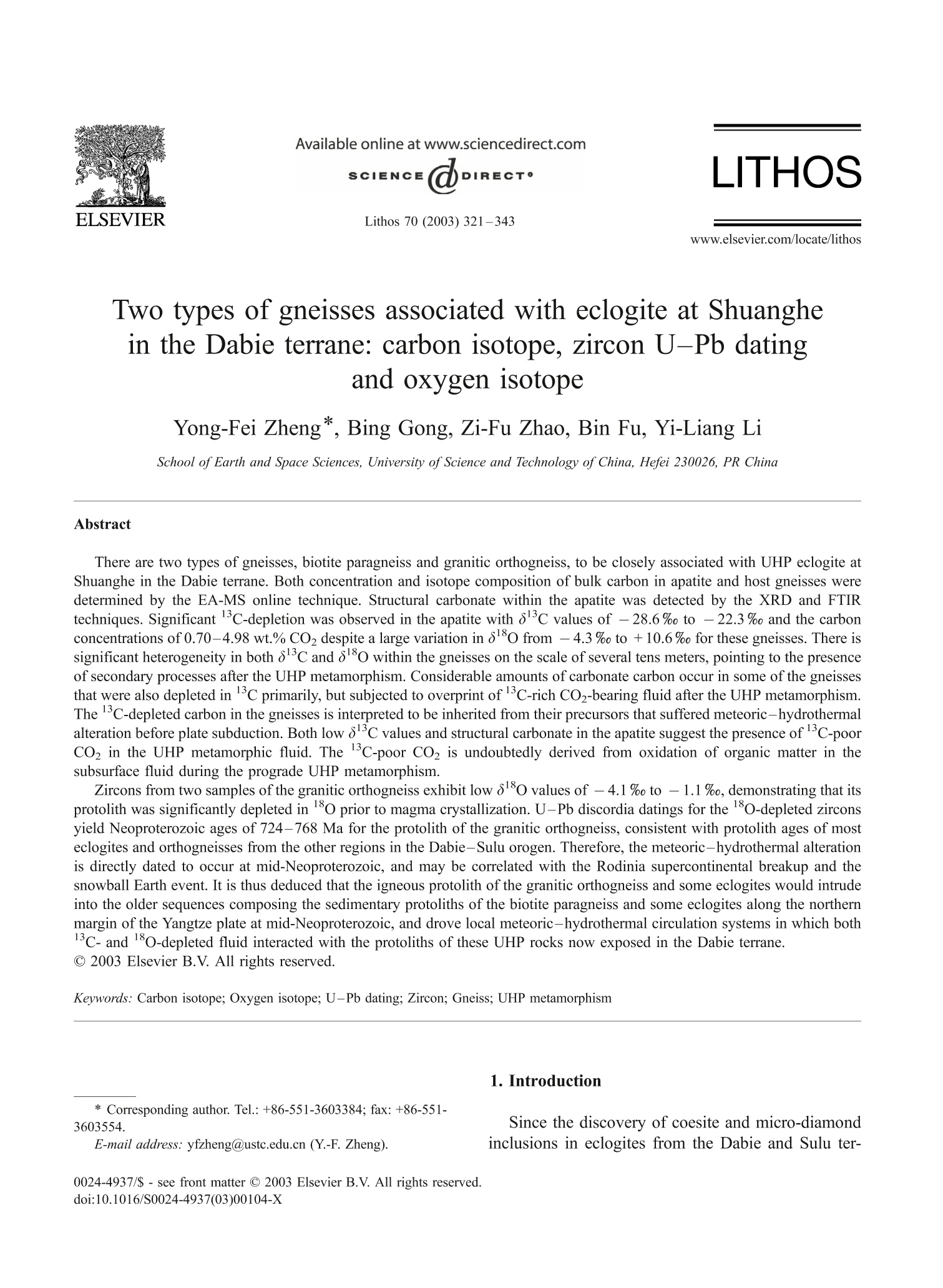



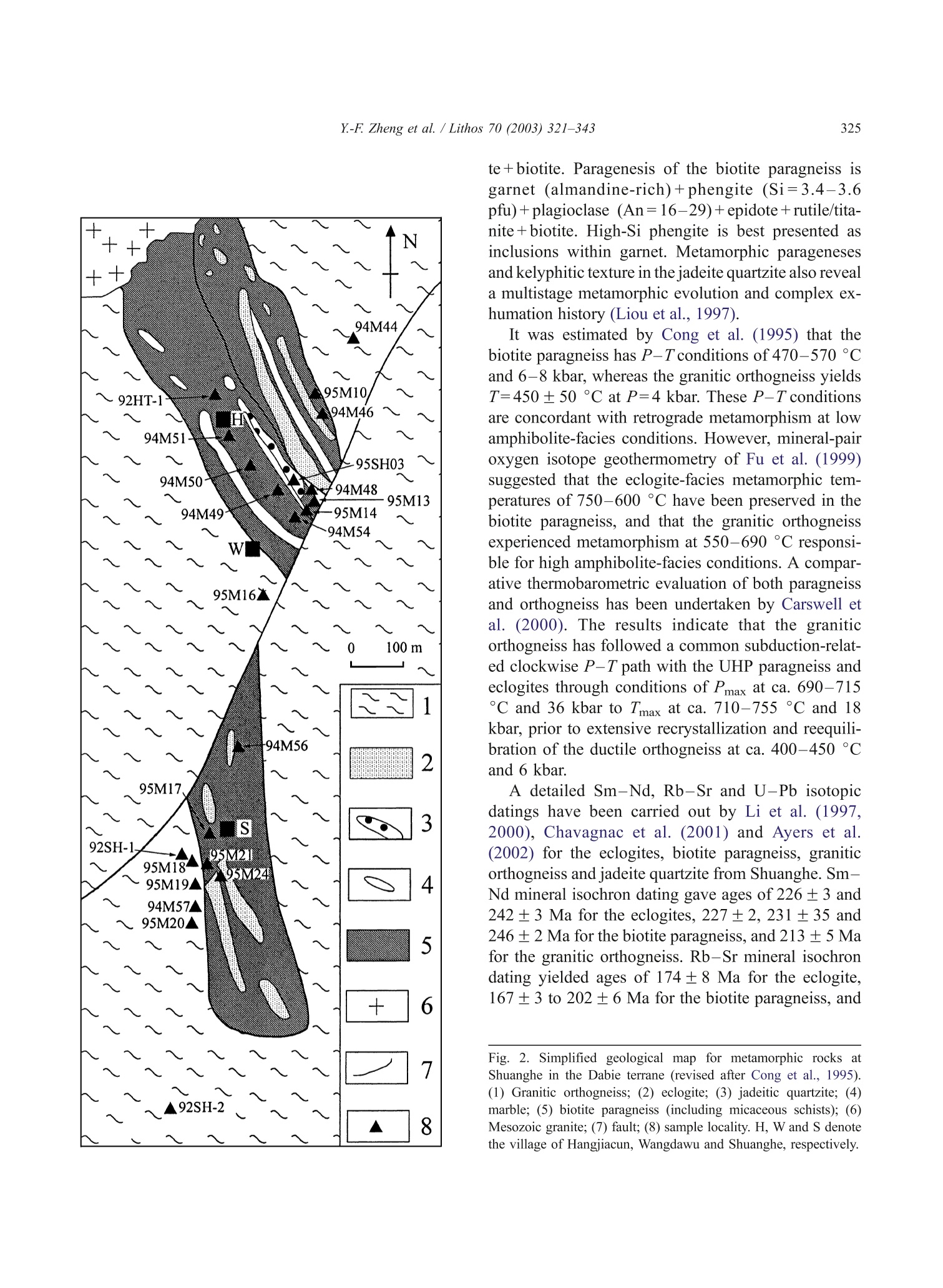
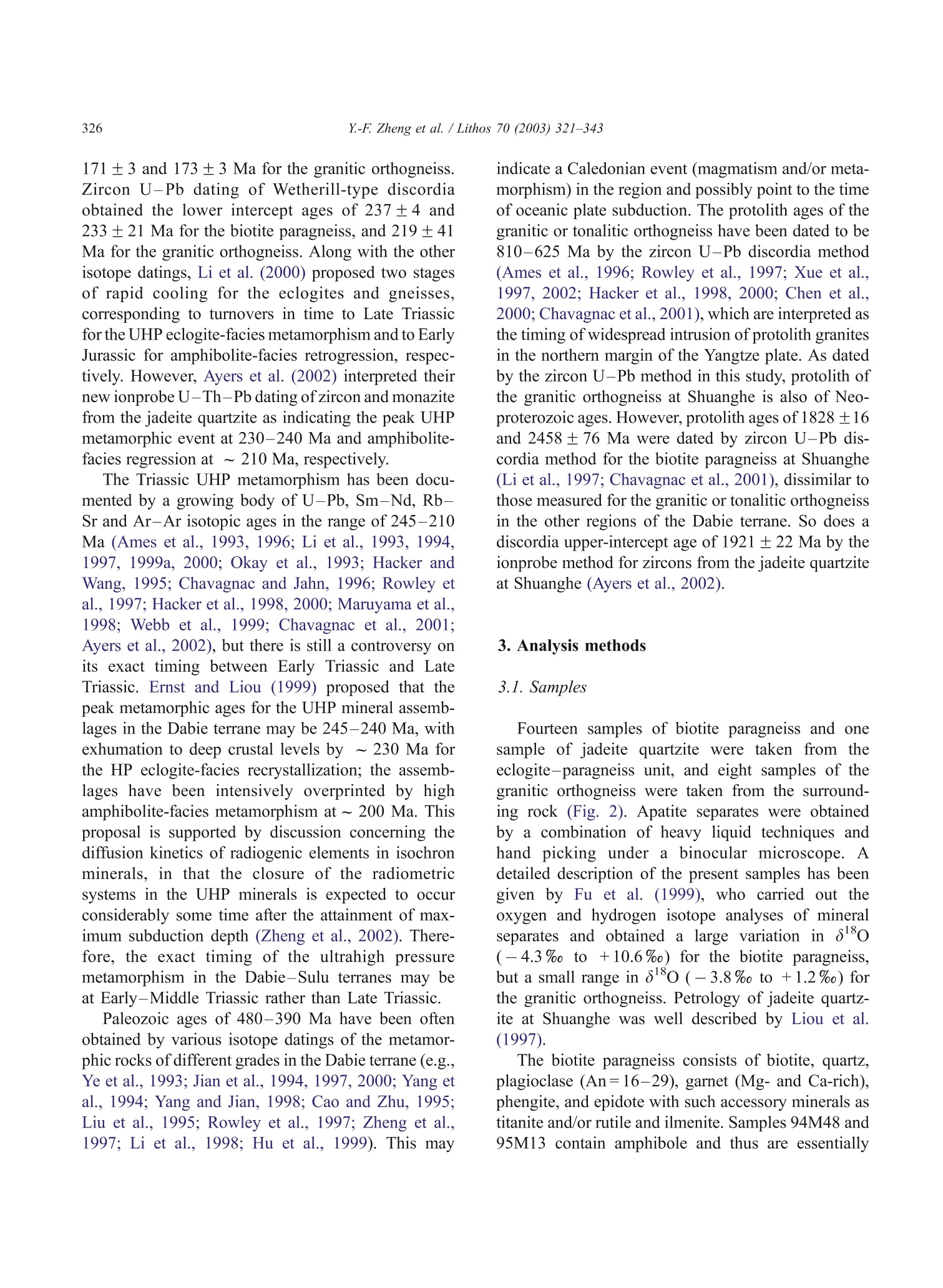
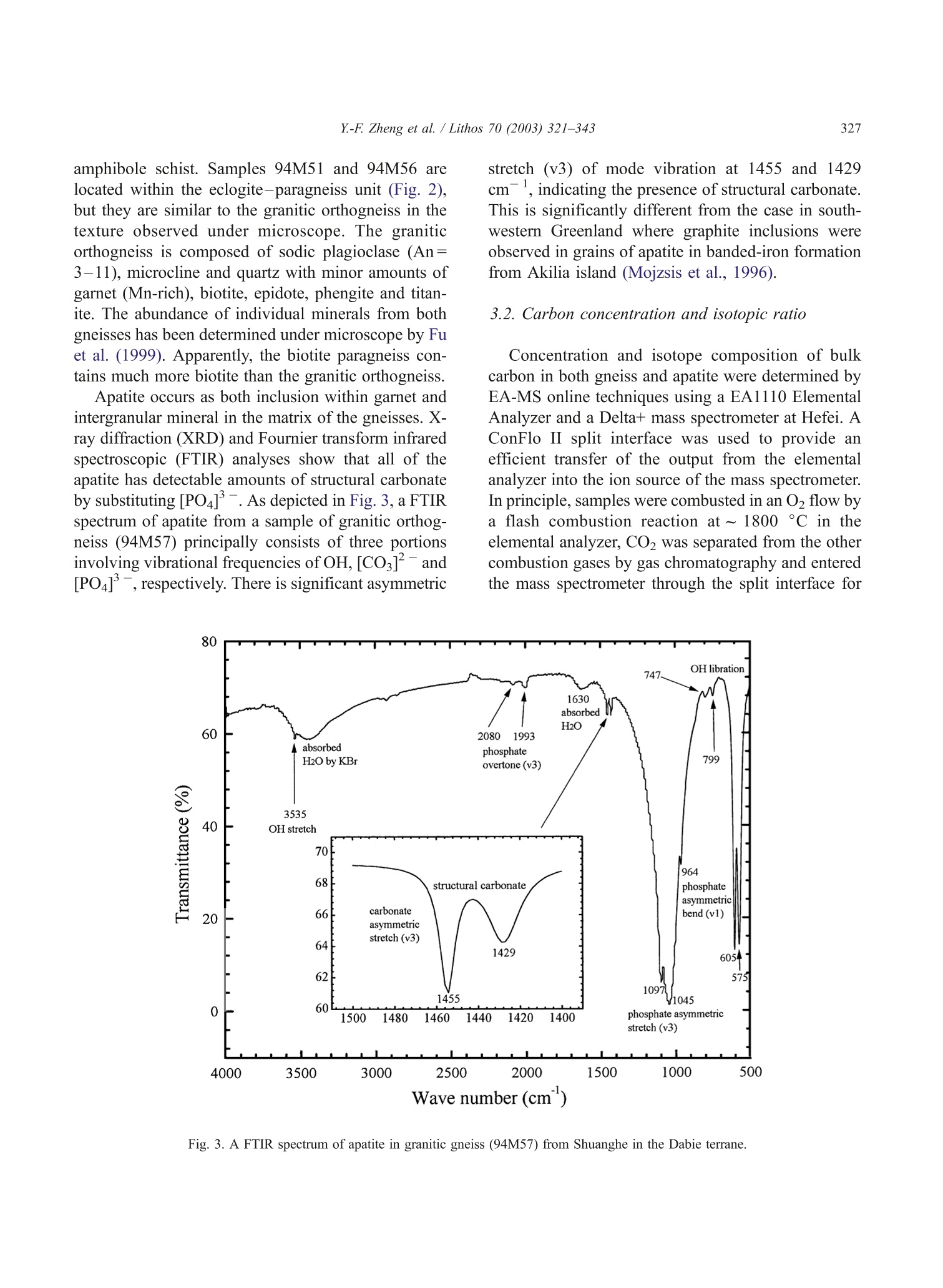

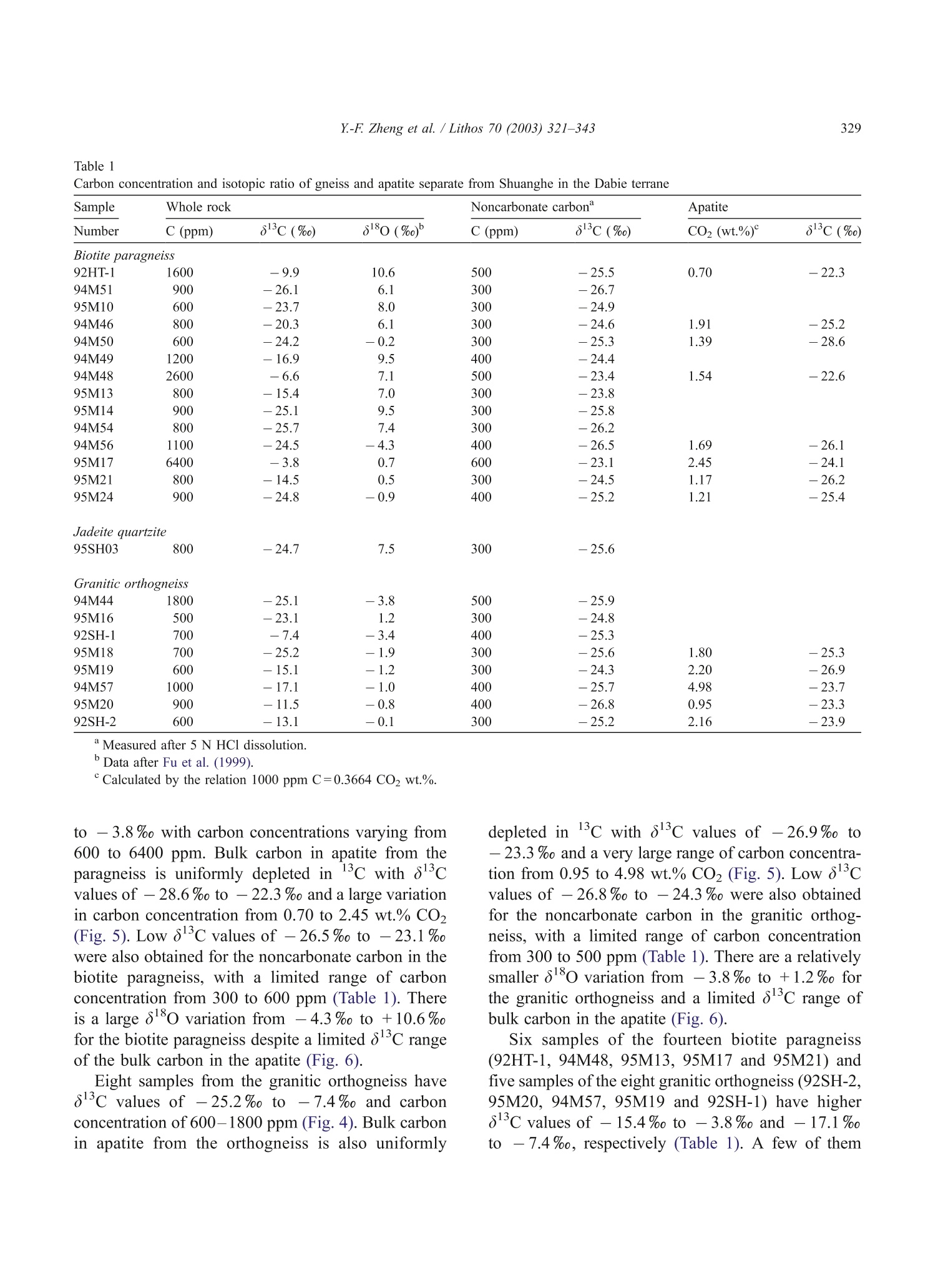
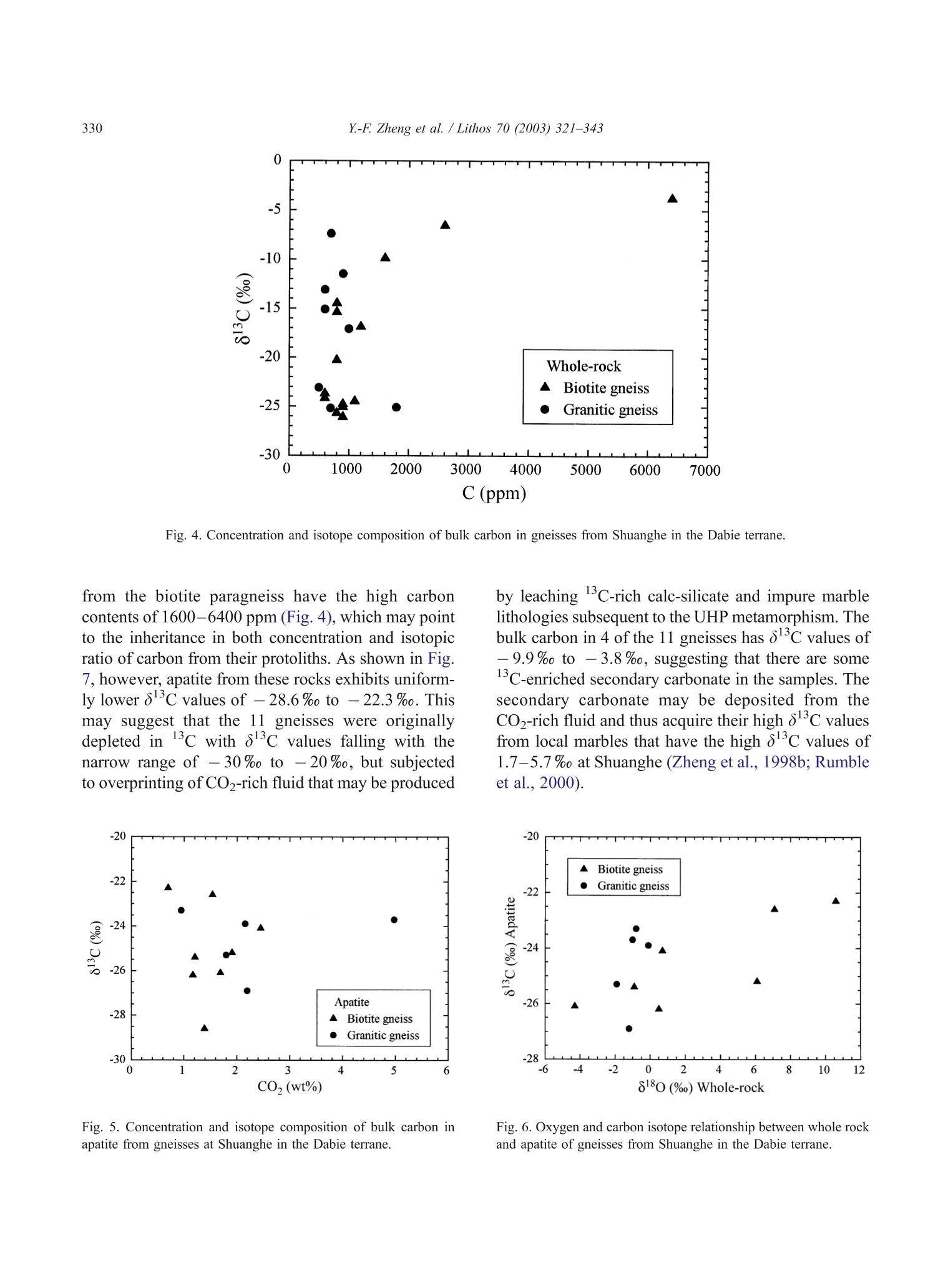
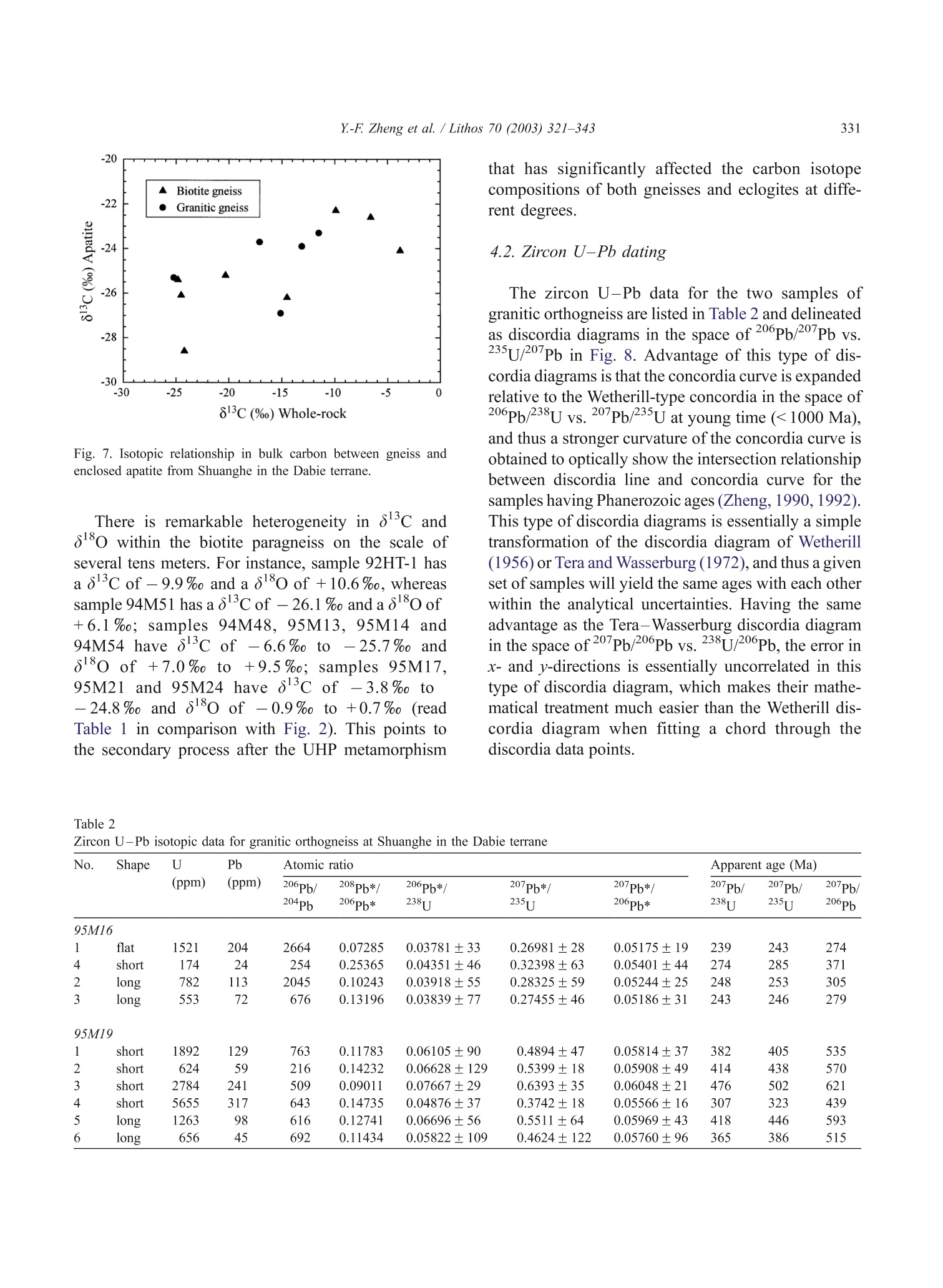

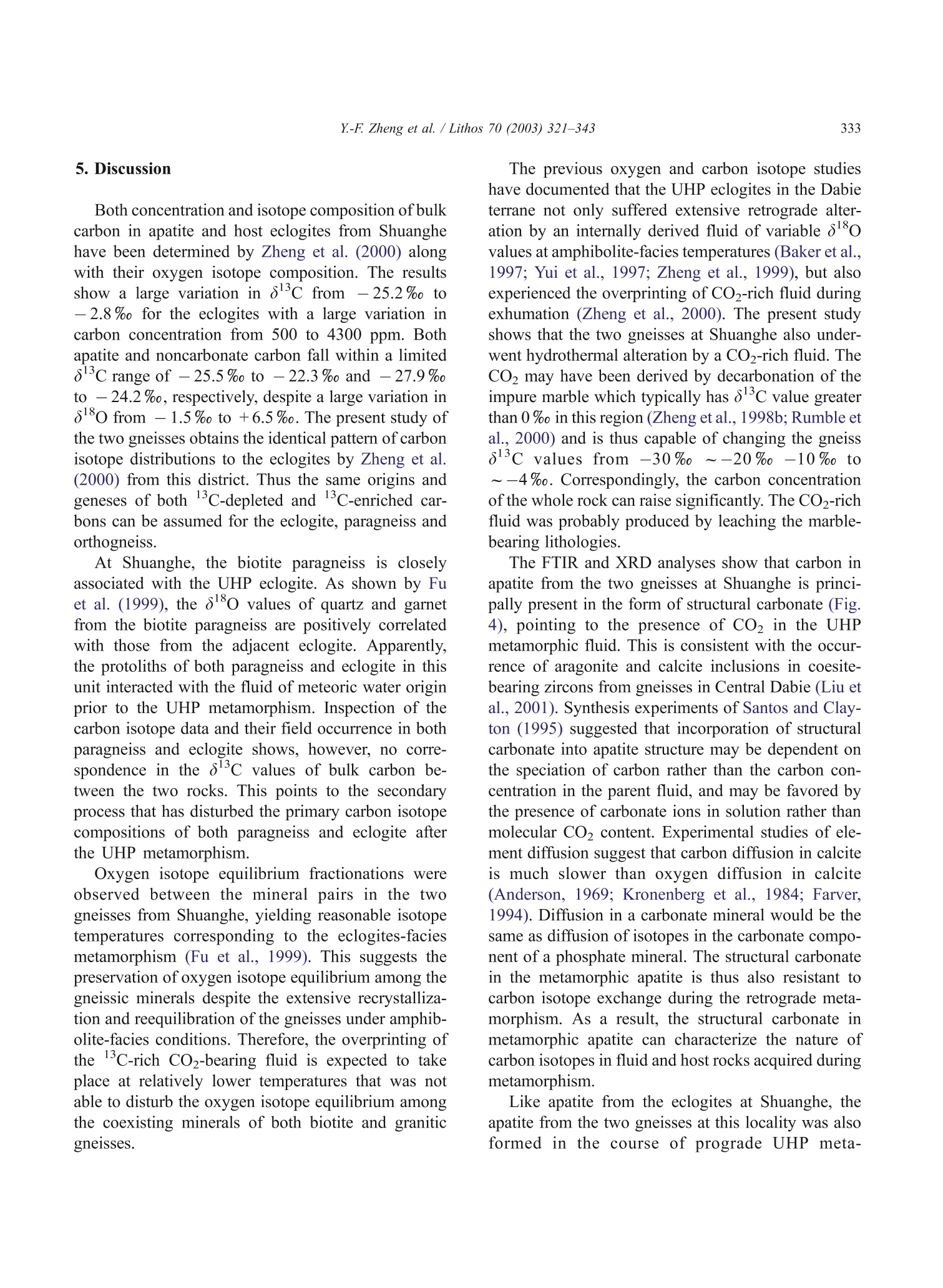
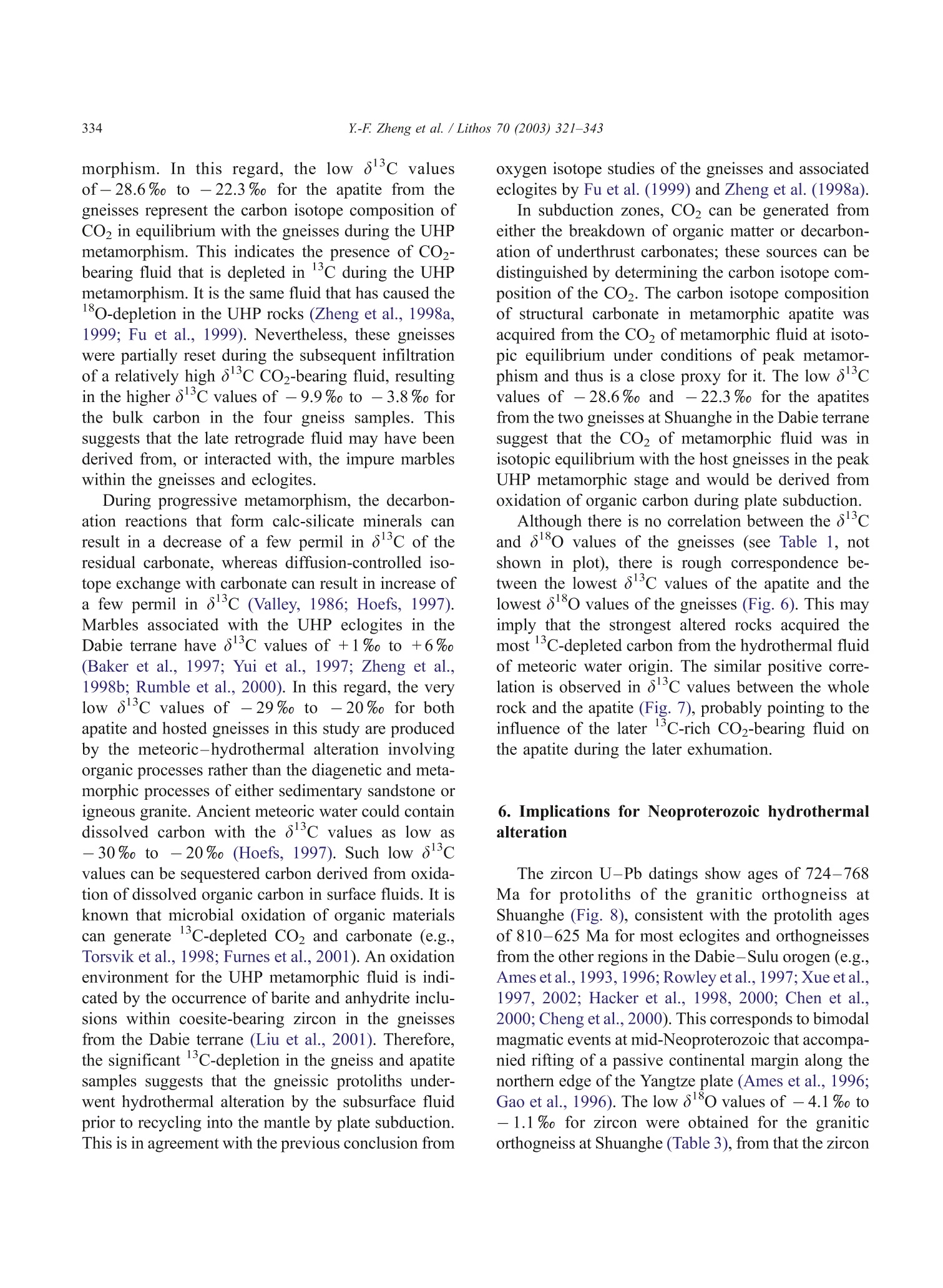
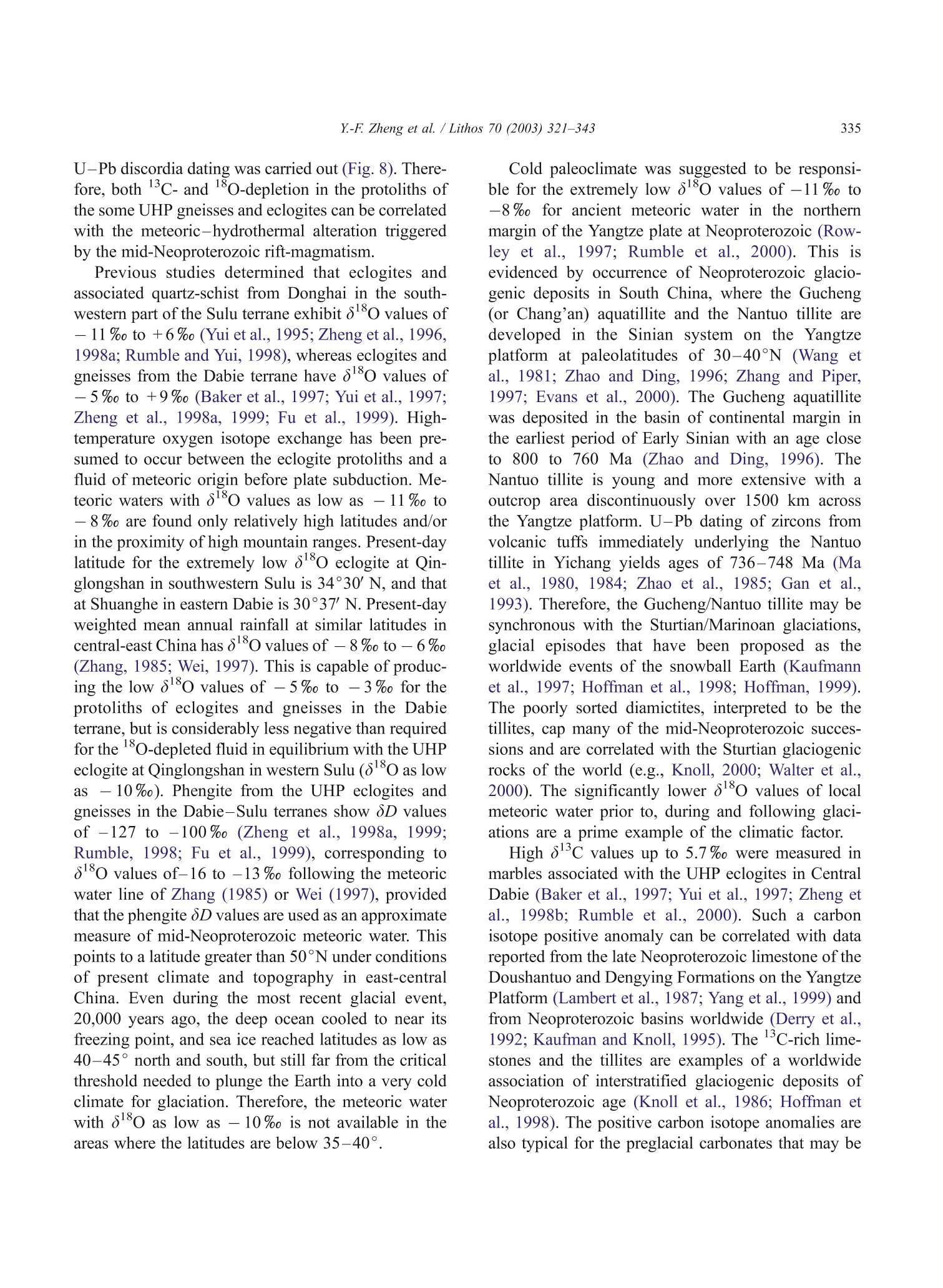

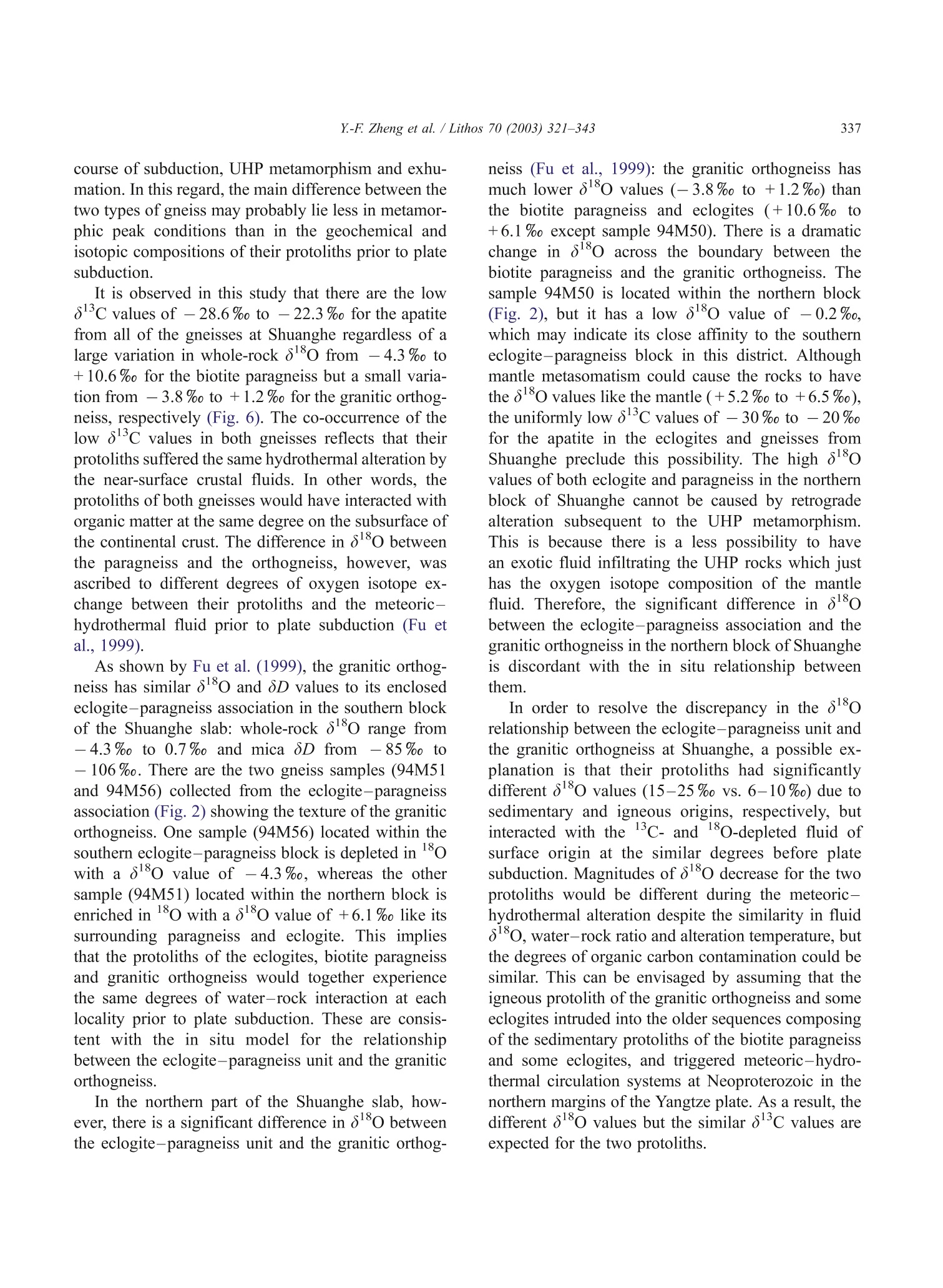
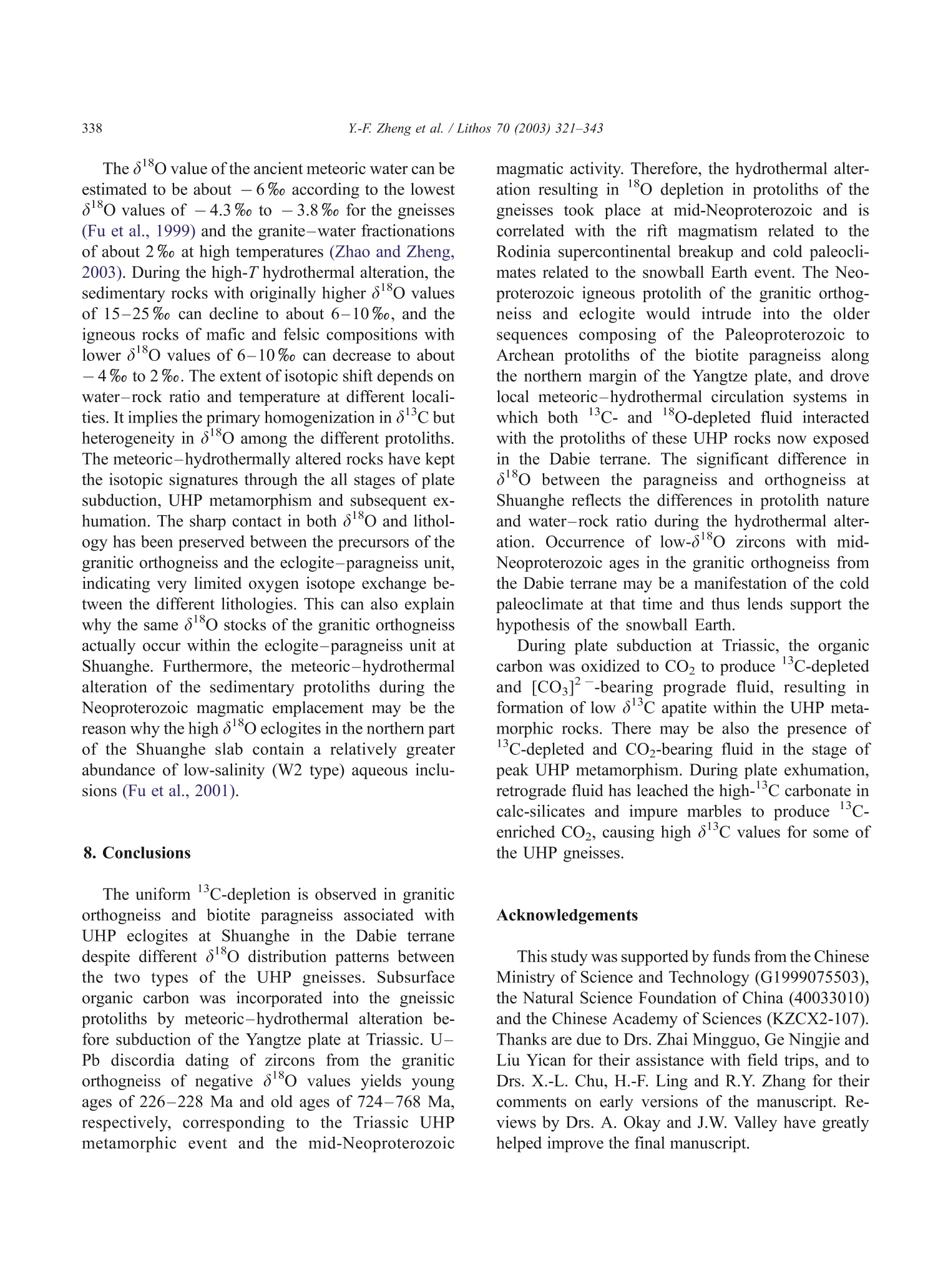
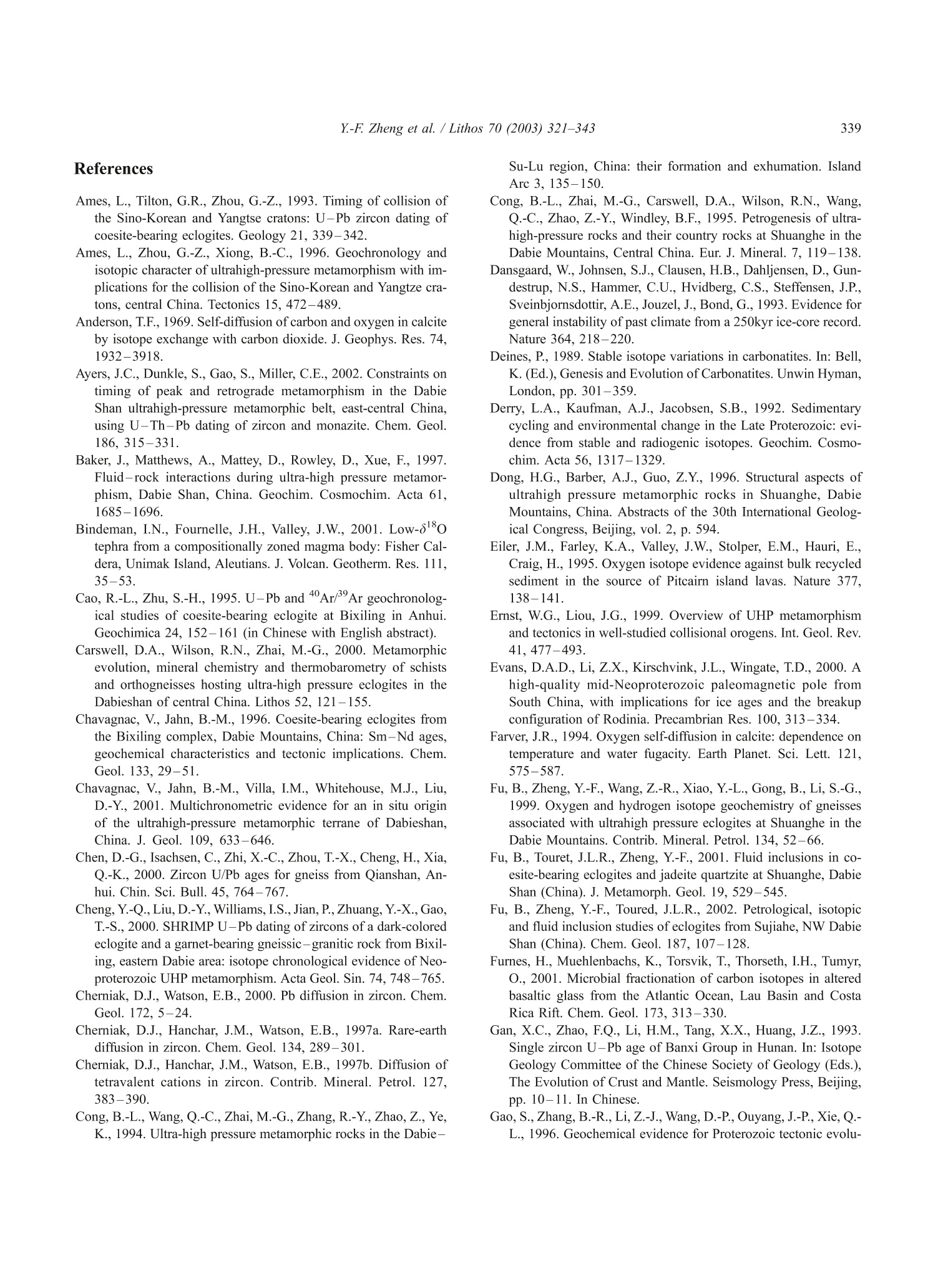

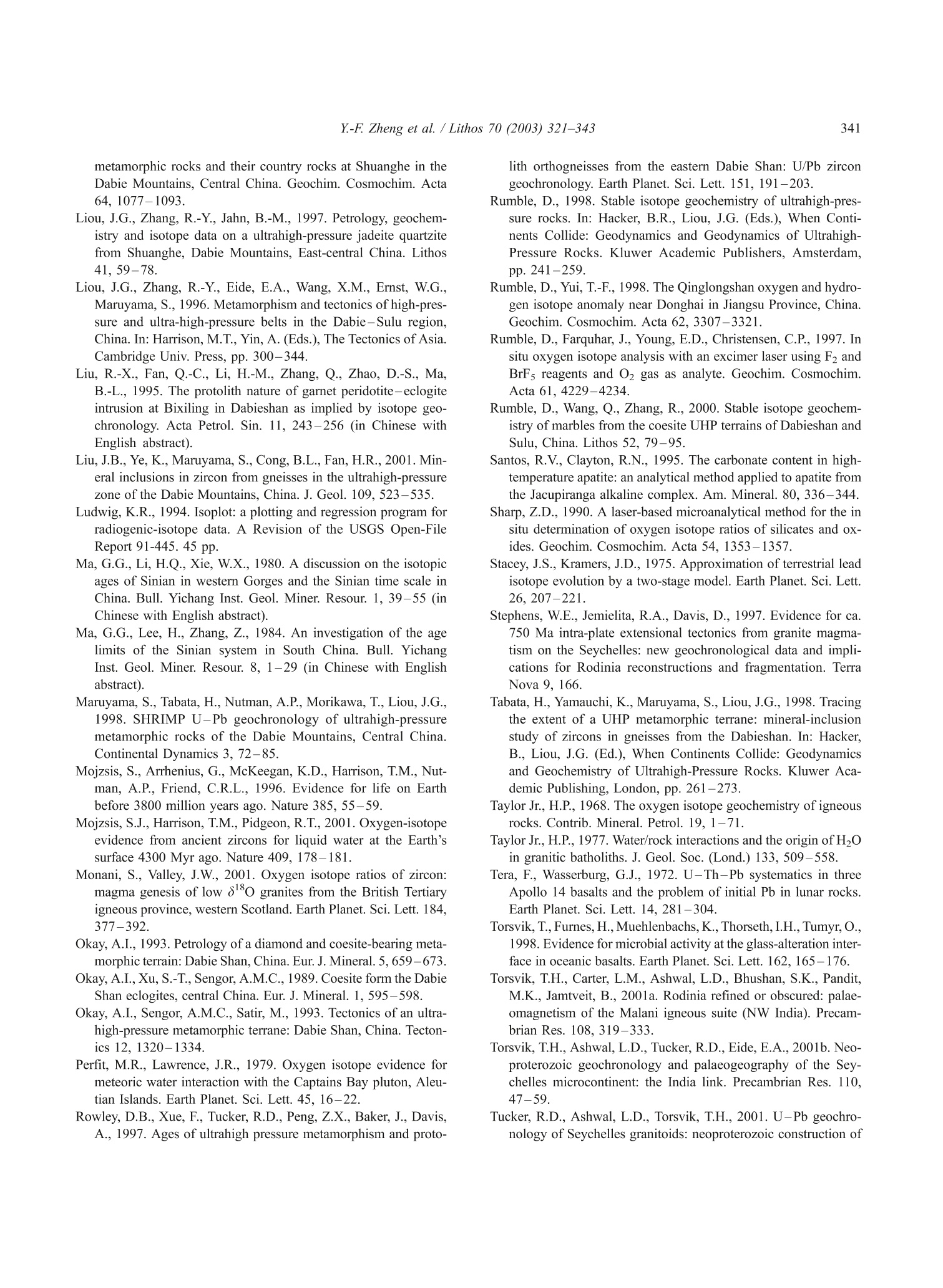
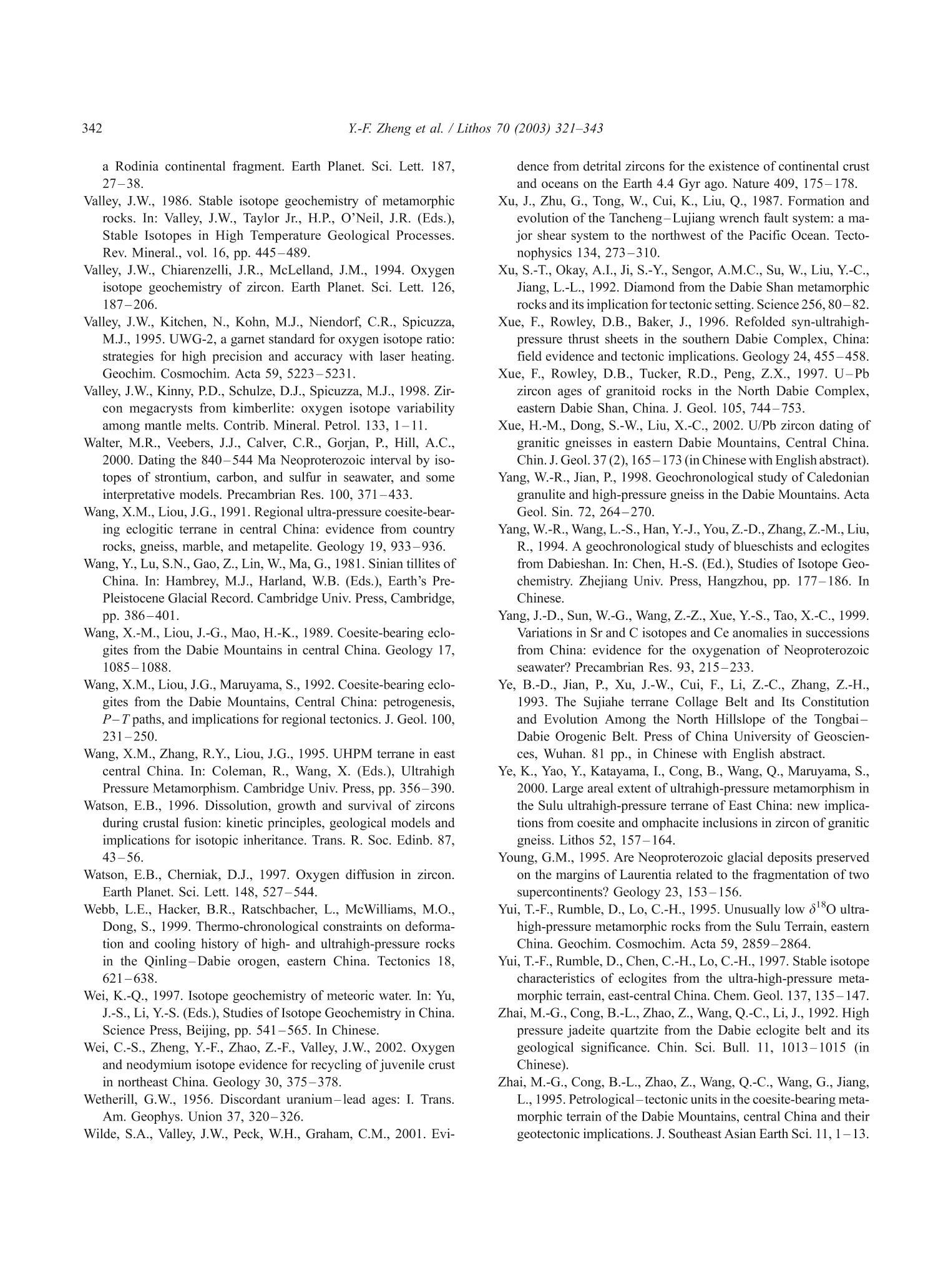

还剩21页未读,是否继续阅读?
上海凯来仪器有限公司为您提供《片麻岩和榴辉岩中碳同位素、锆石U-Pb测年和氧同位素检测方案(激光剥蚀进样)》,该方案主要用于其他中碳同位素、锆石U-Pb测年和氧同位素检测,参考标准--,《片麻岩和榴辉岩中碳同位素、锆石U-Pb测年和氧同位素检测方案(激光剥蚀进样)》用到的仪器有
相关方案
更多
该厂商其他方案
更多
